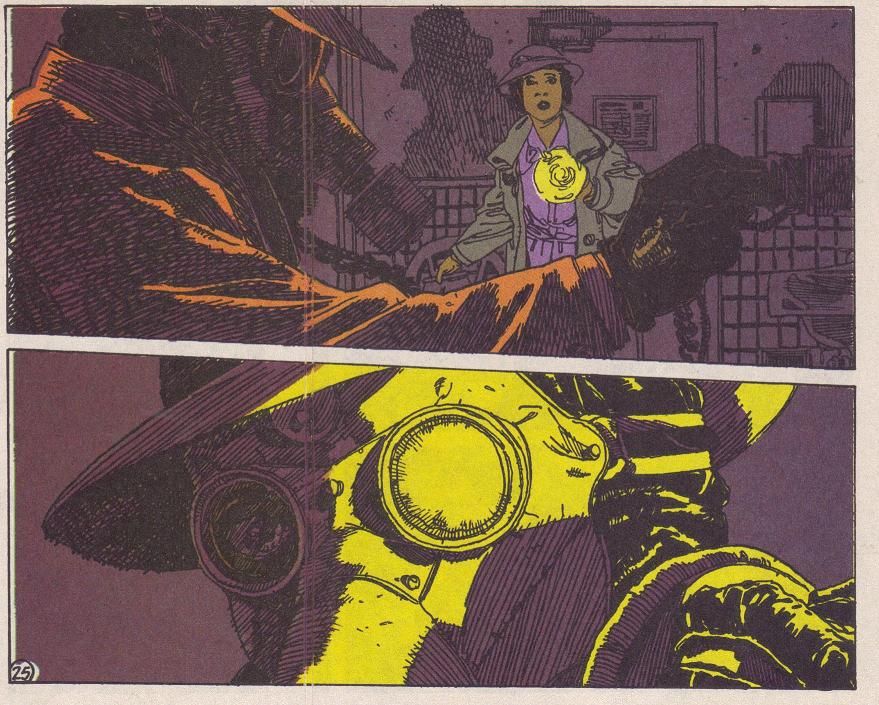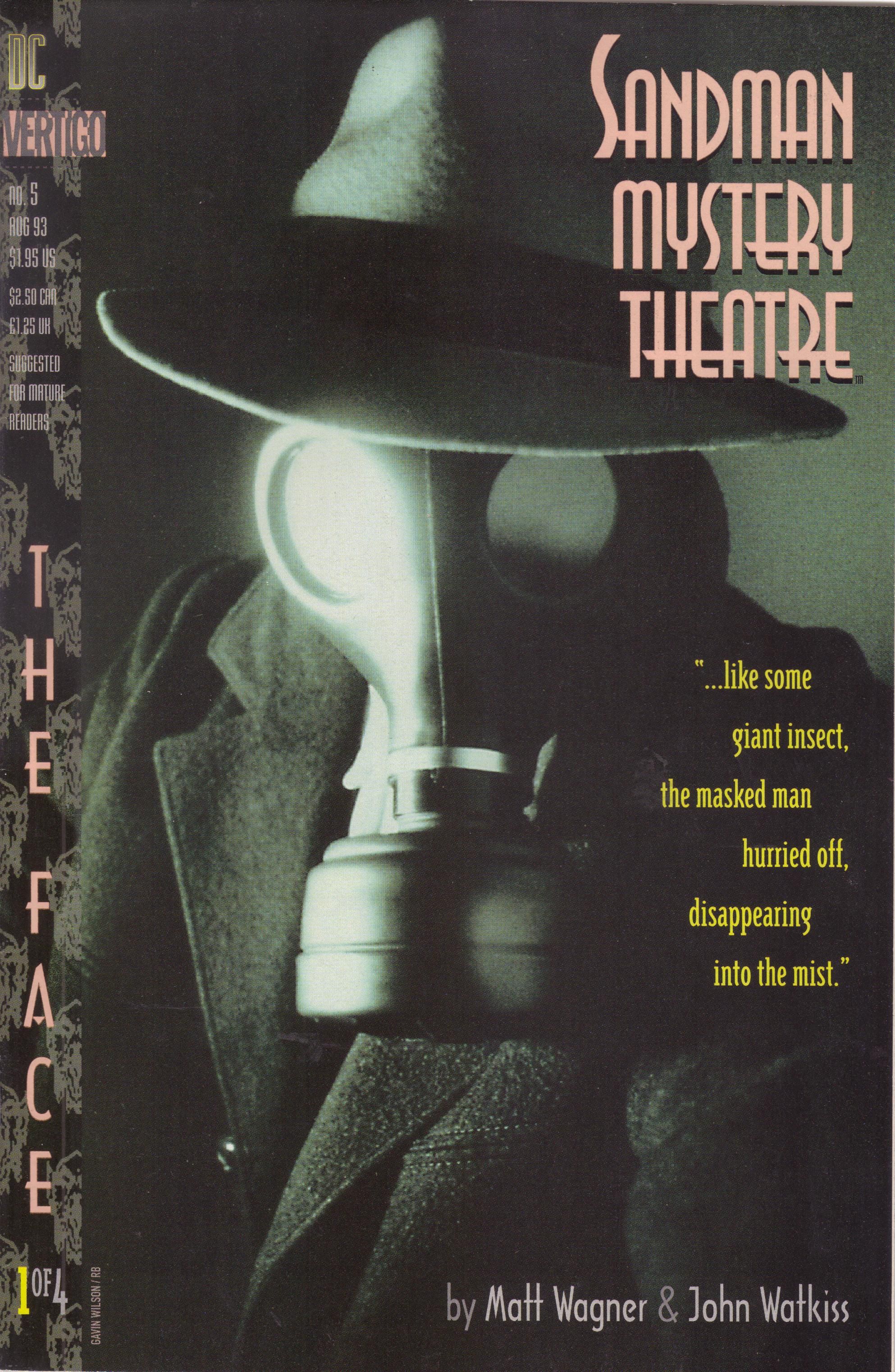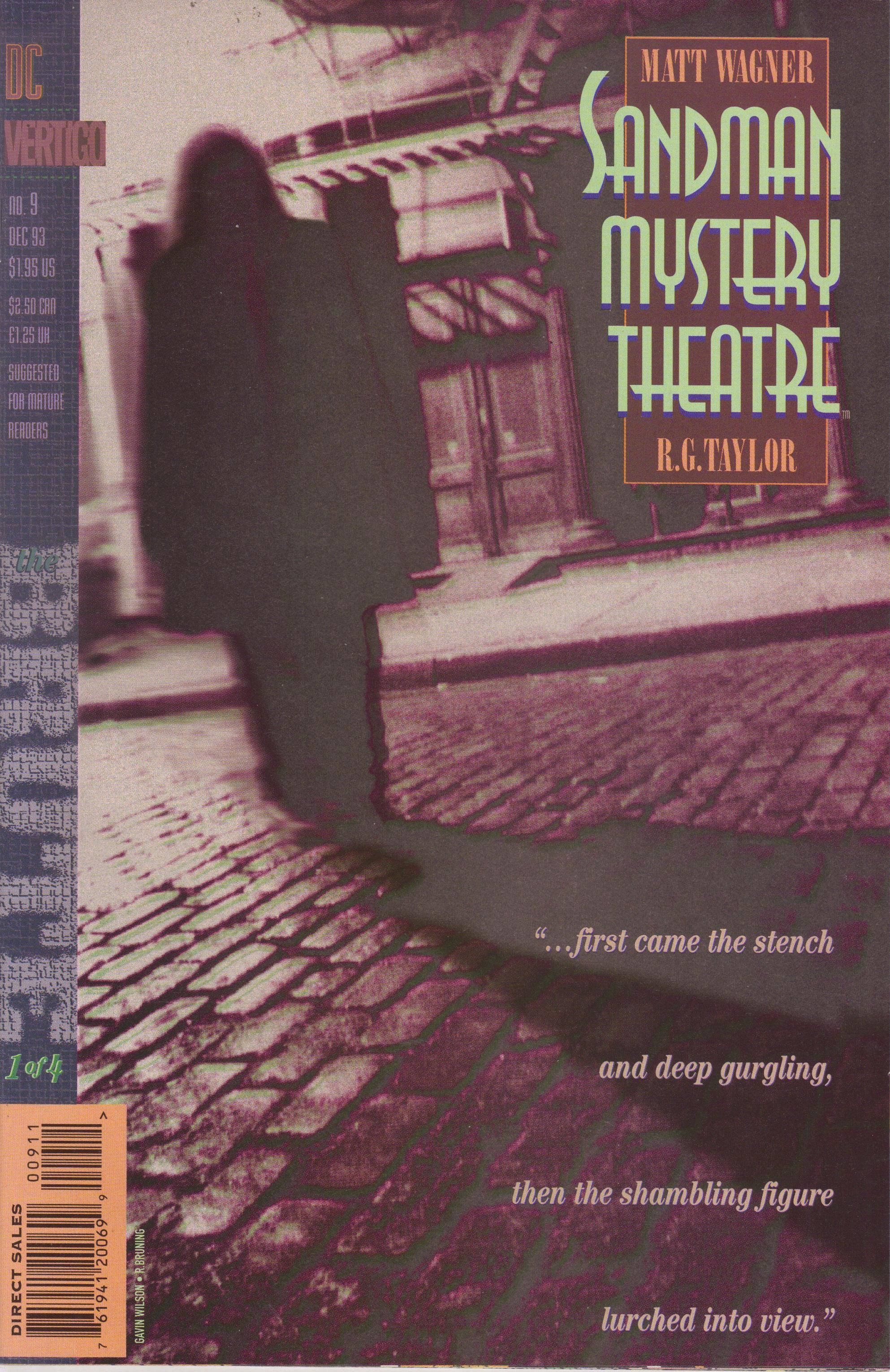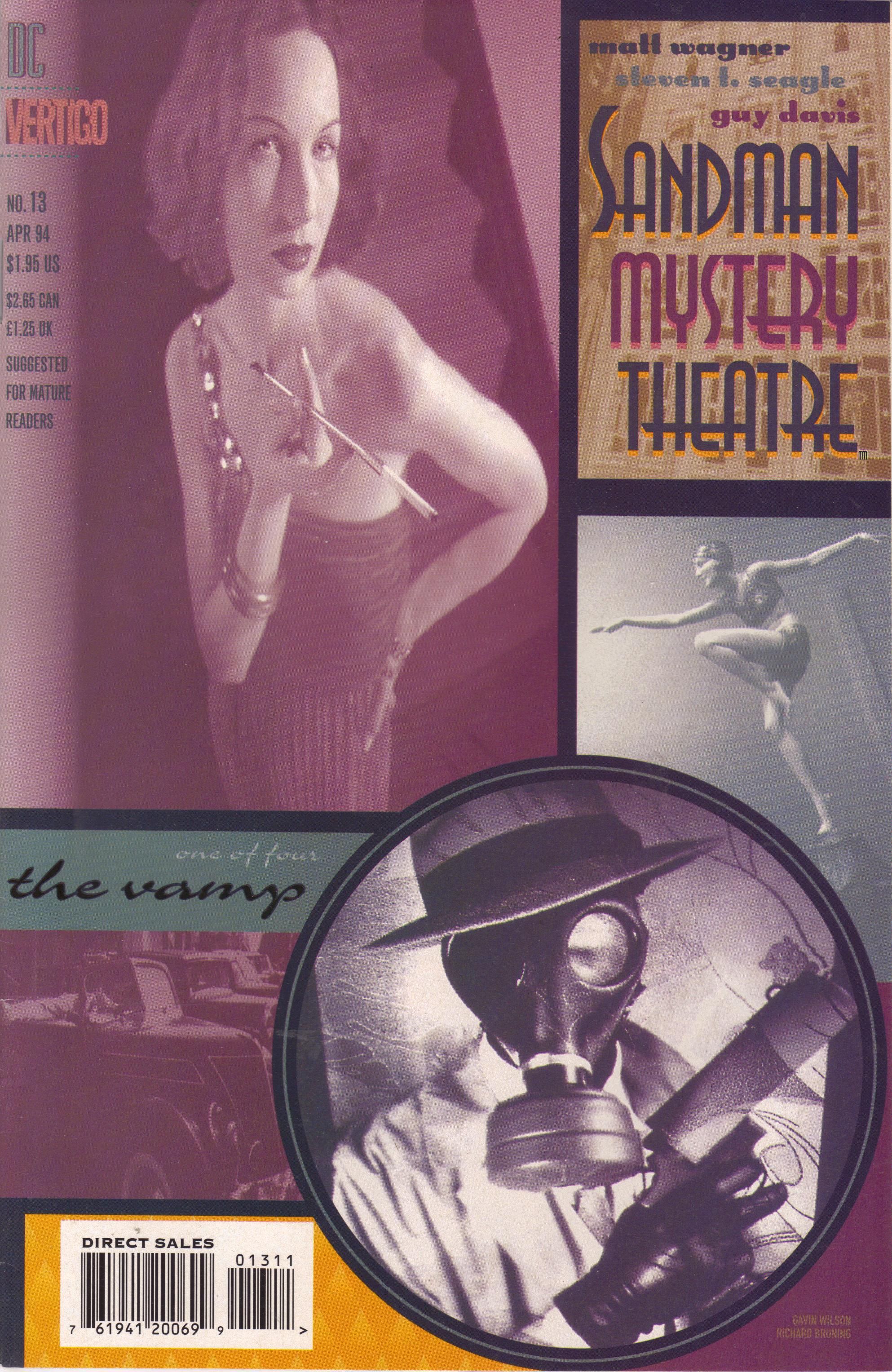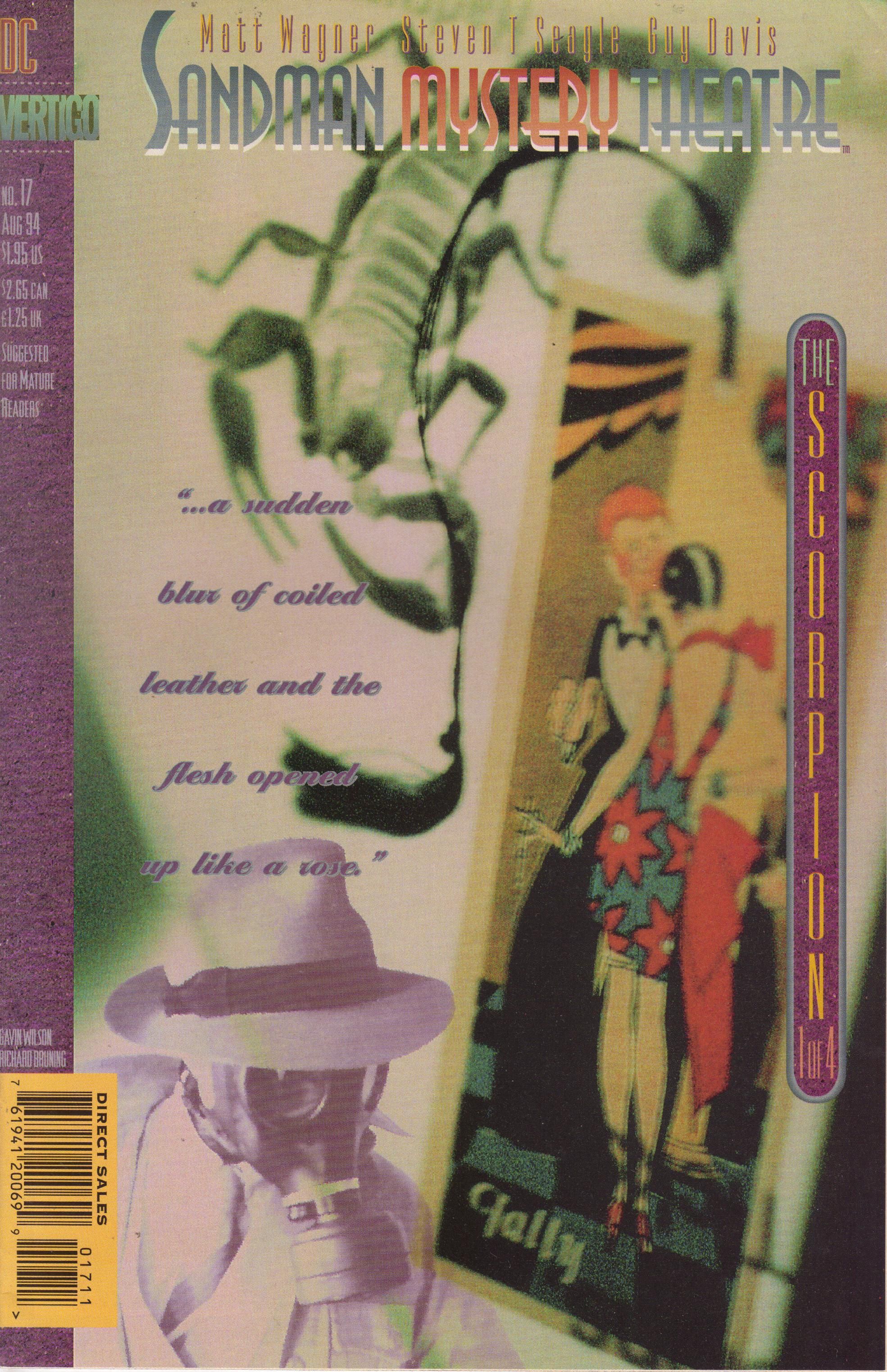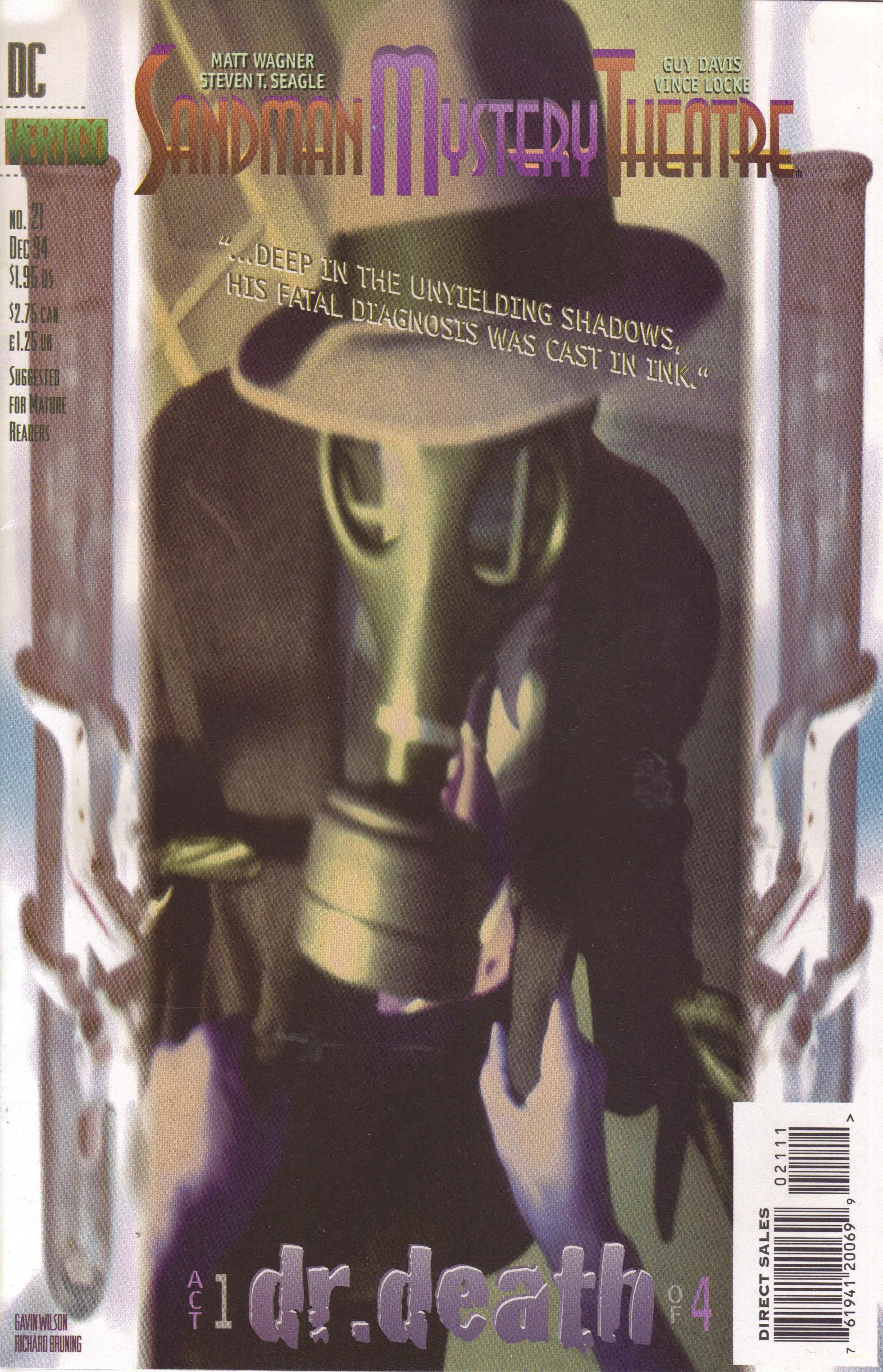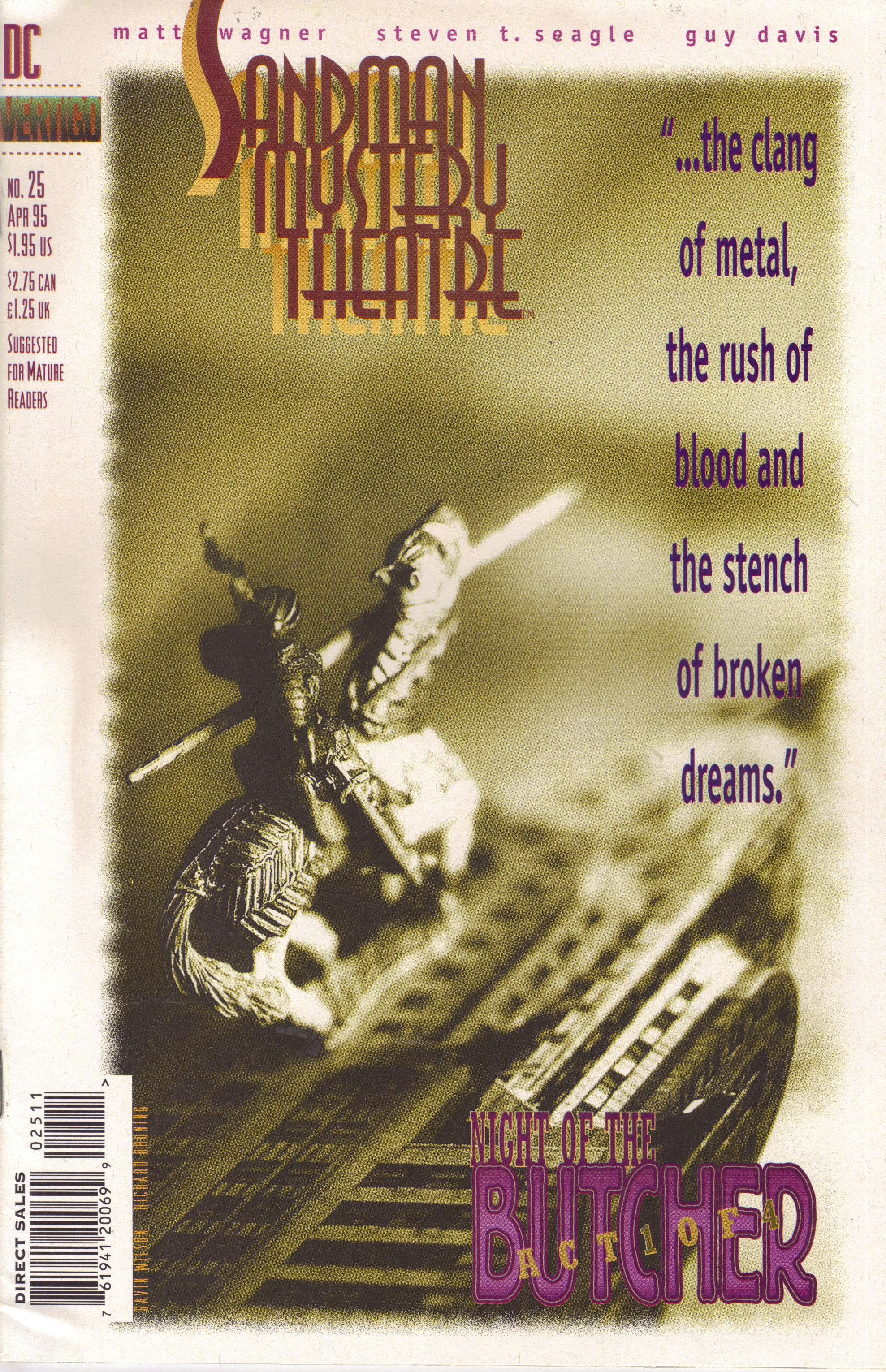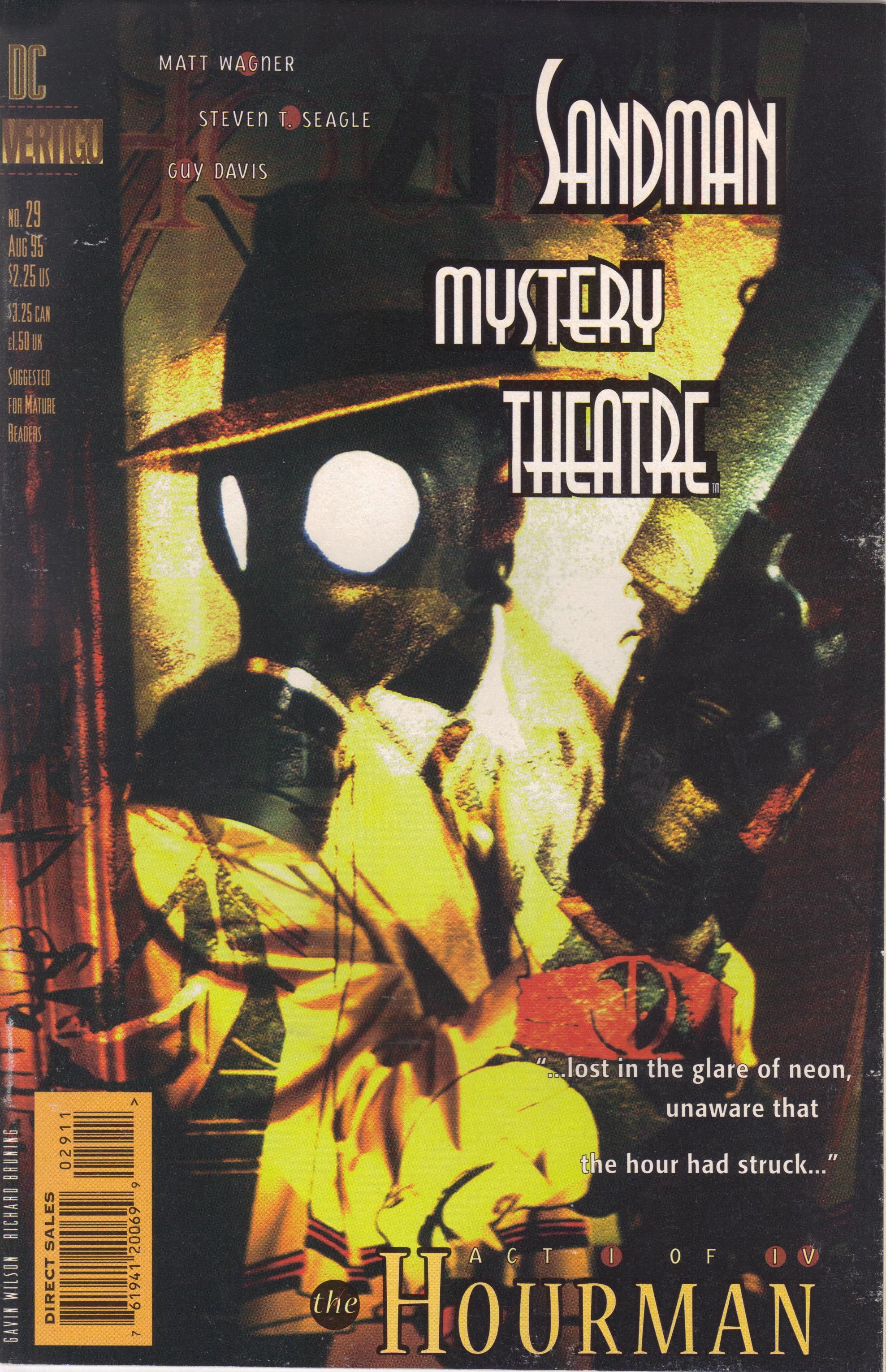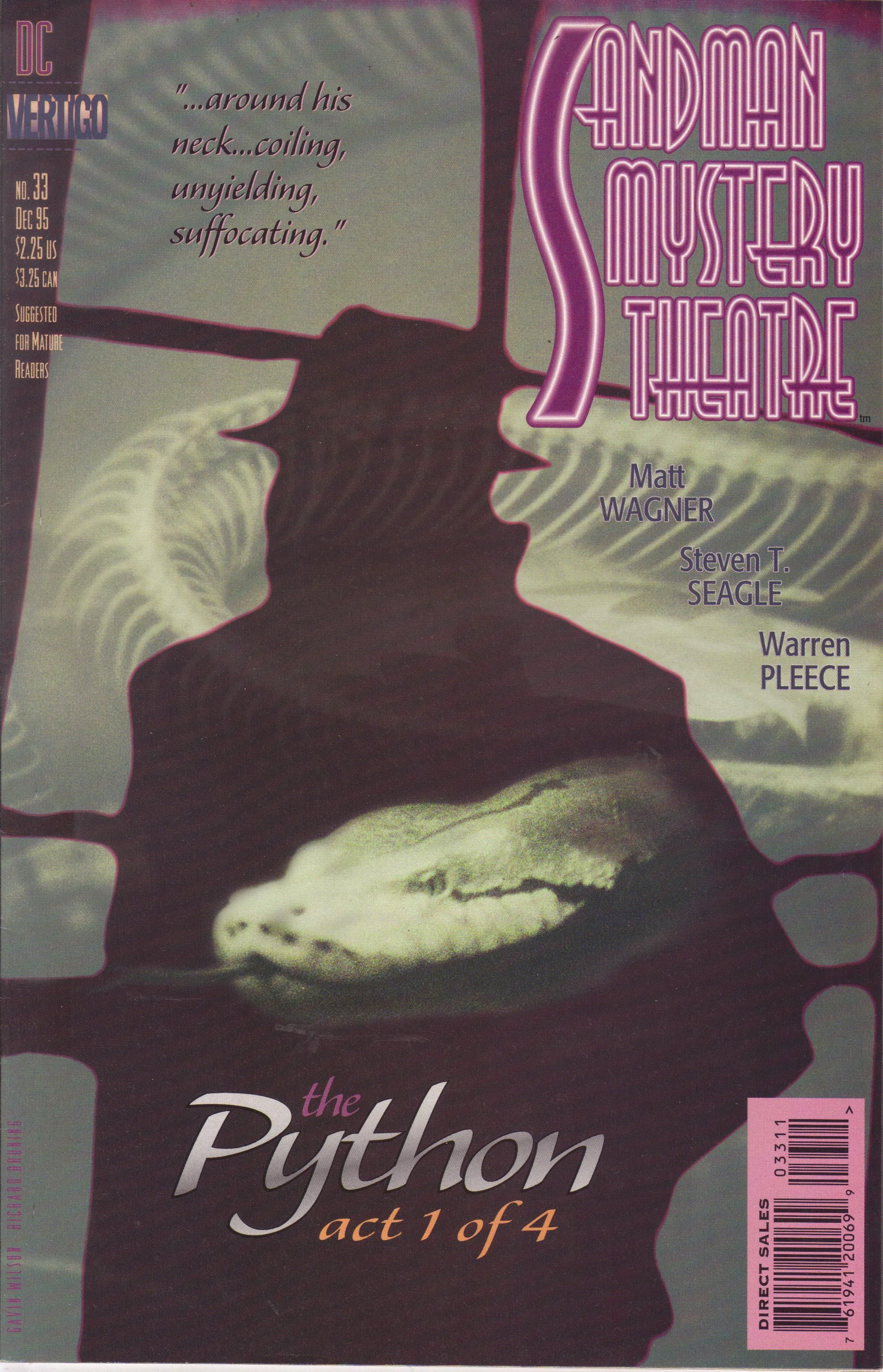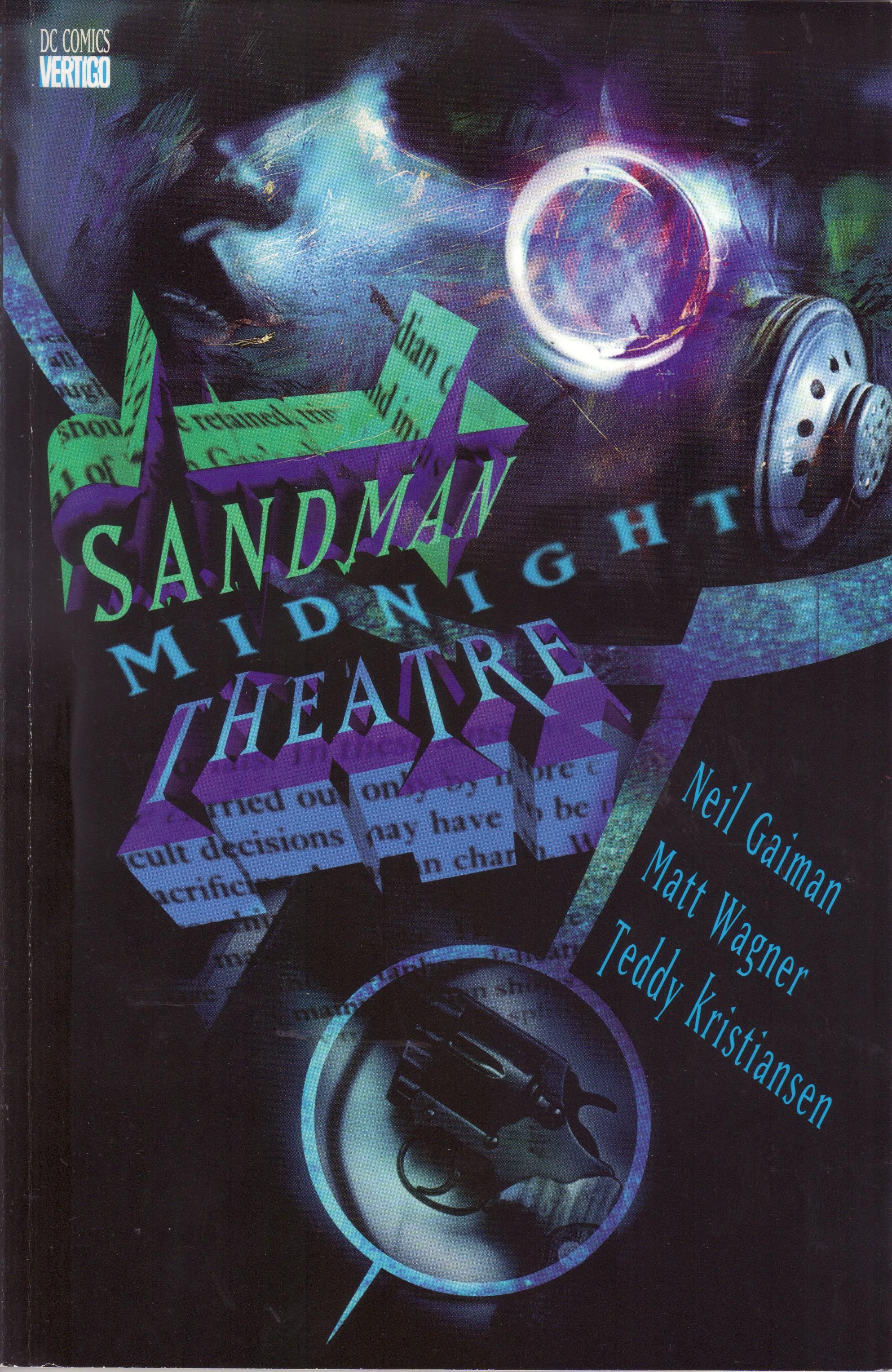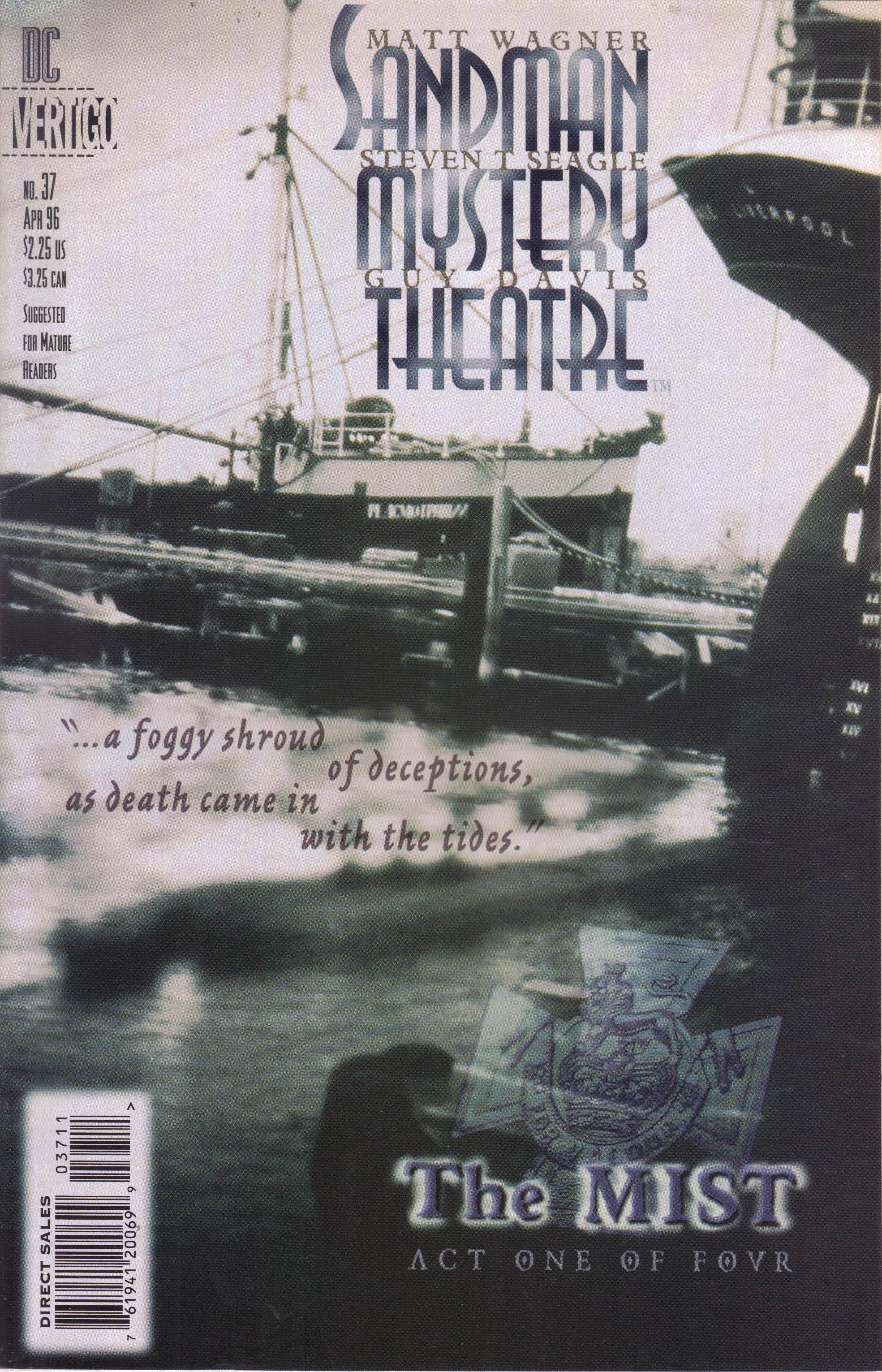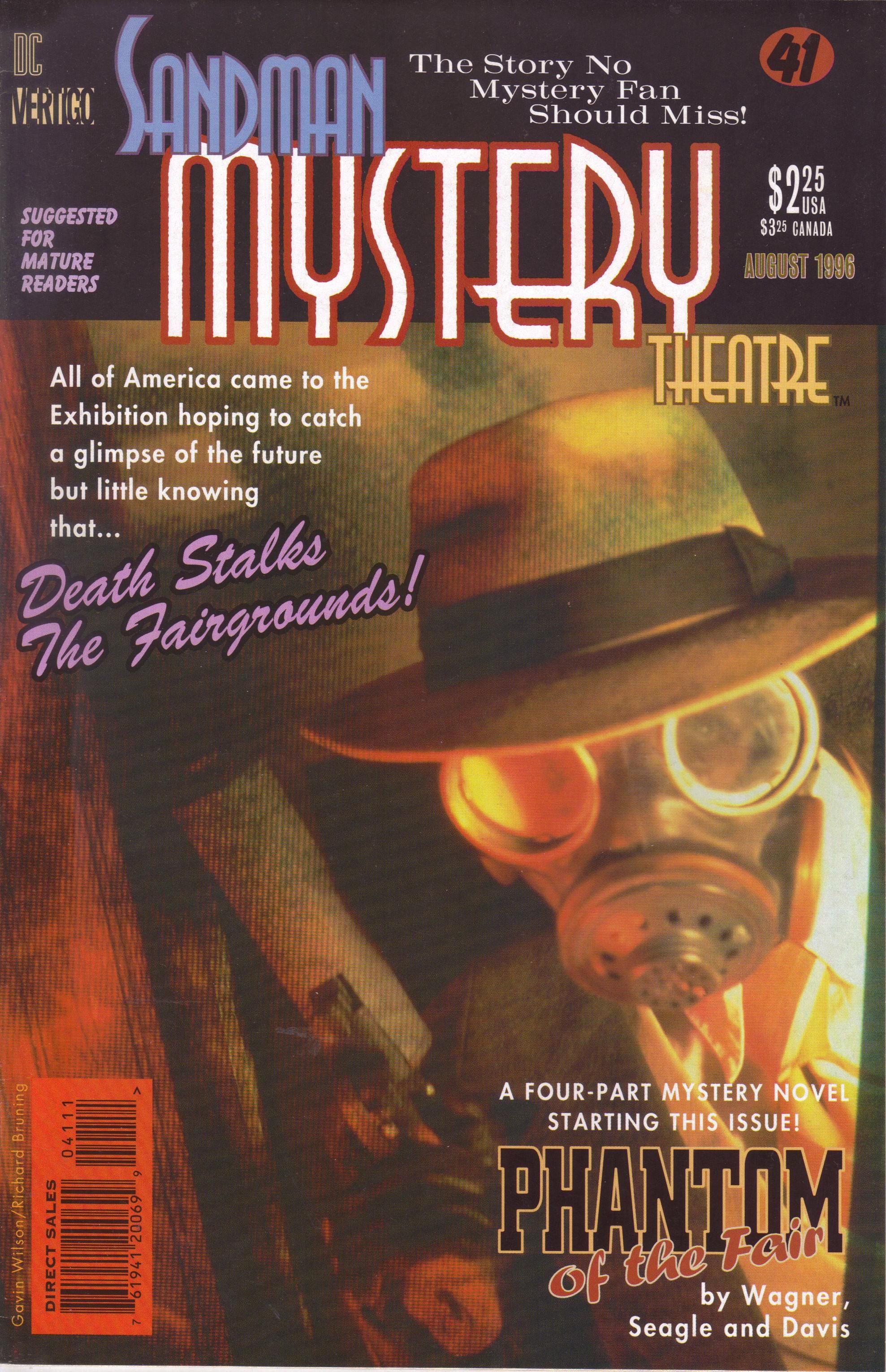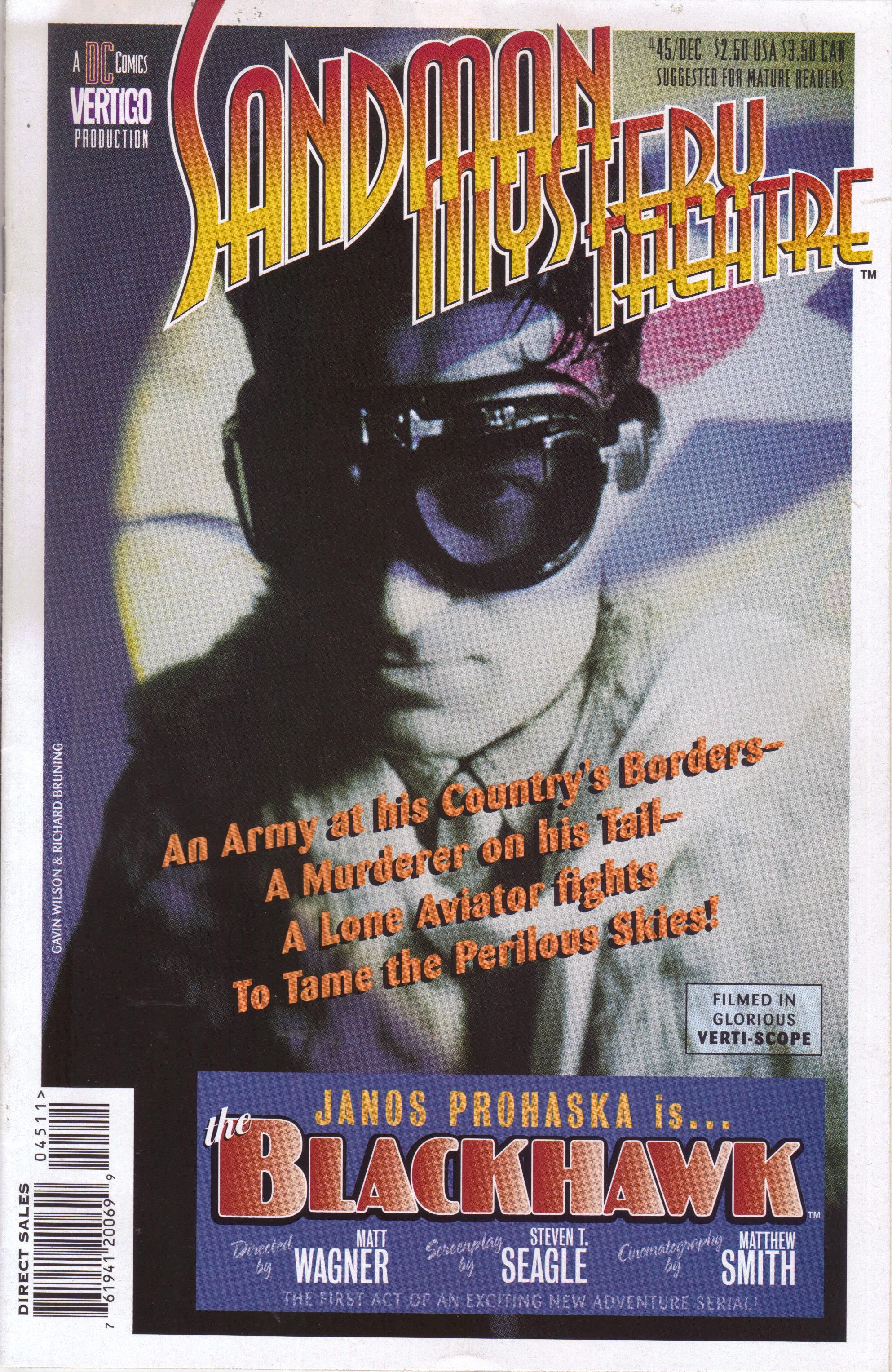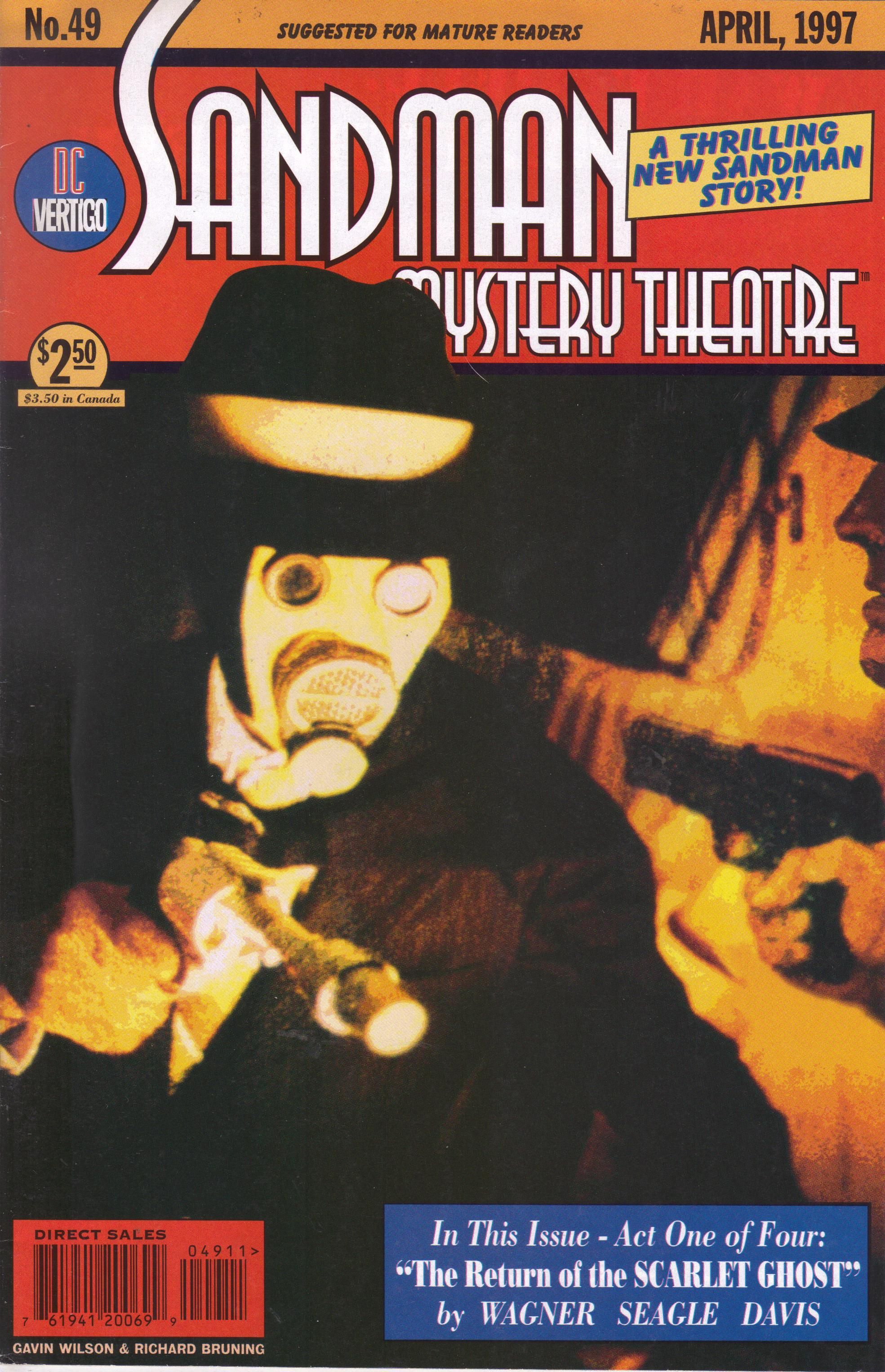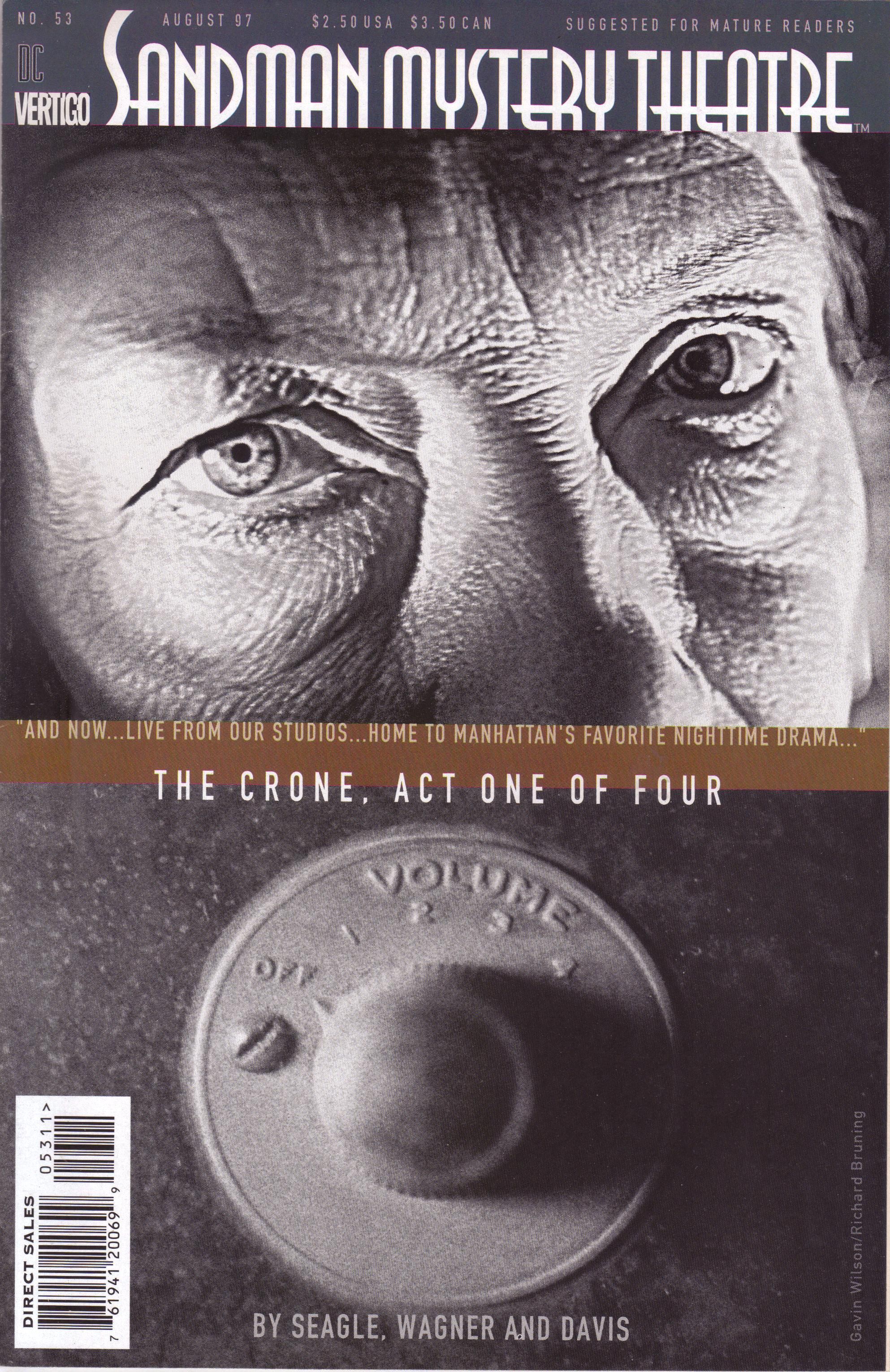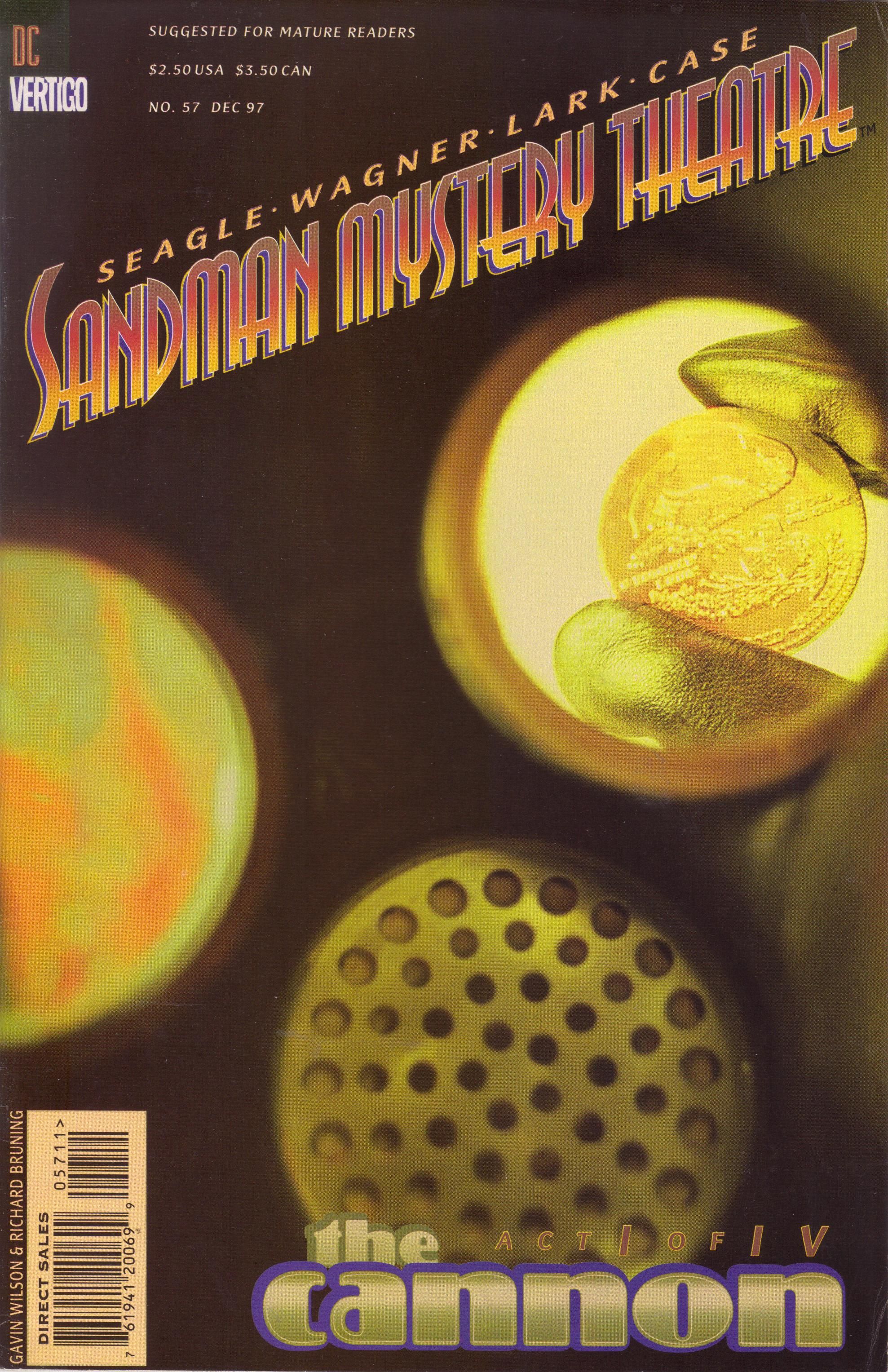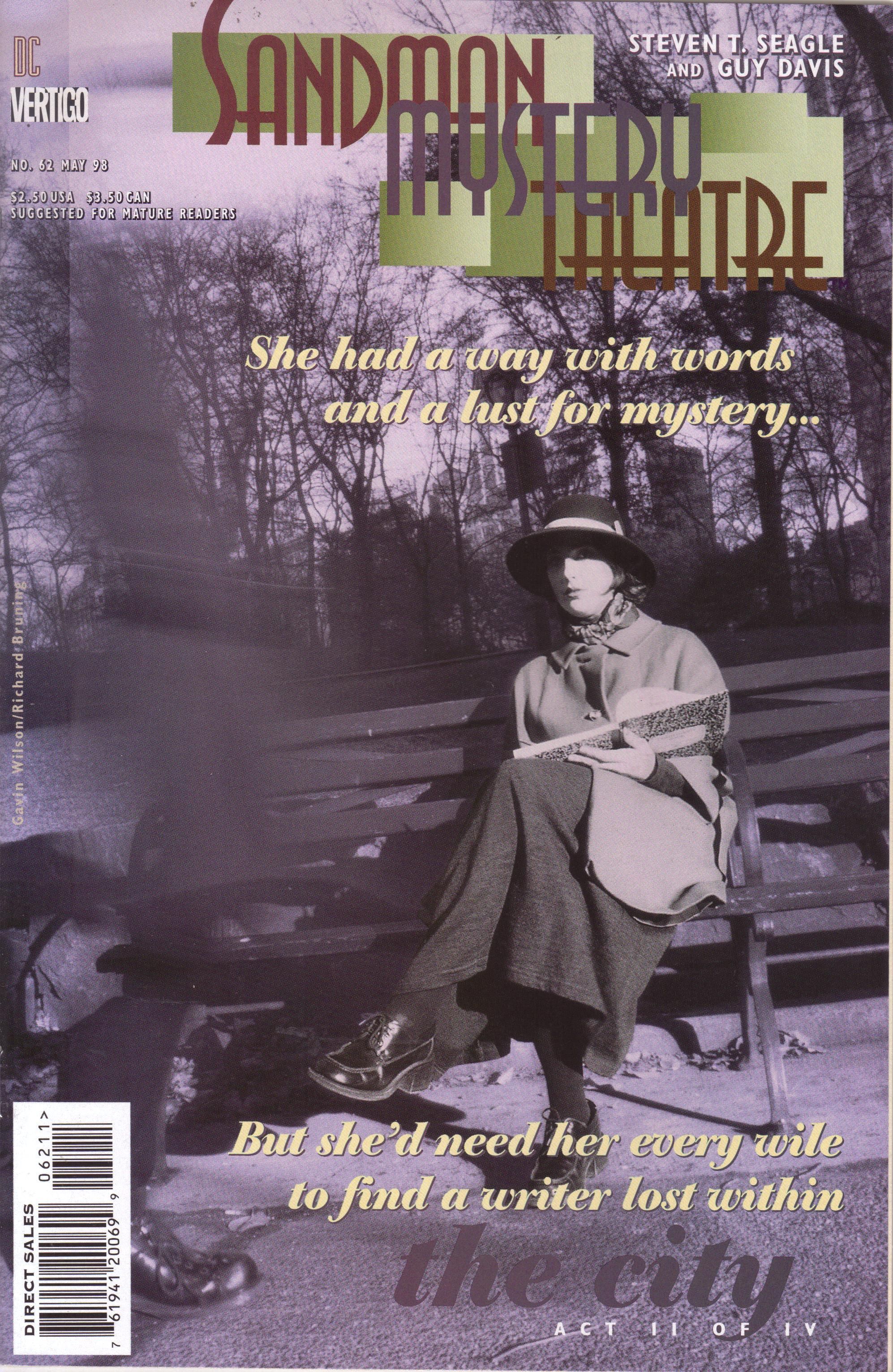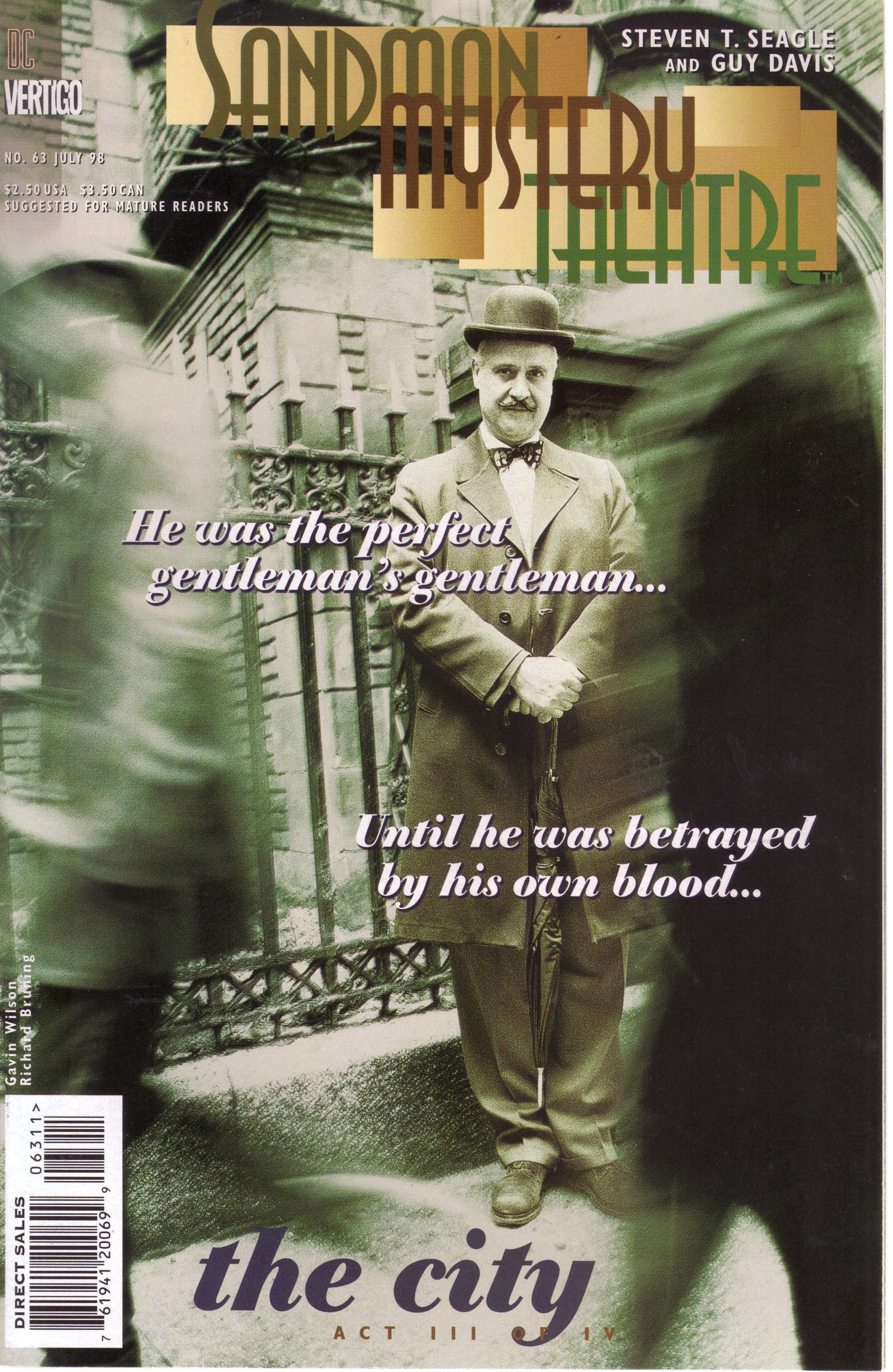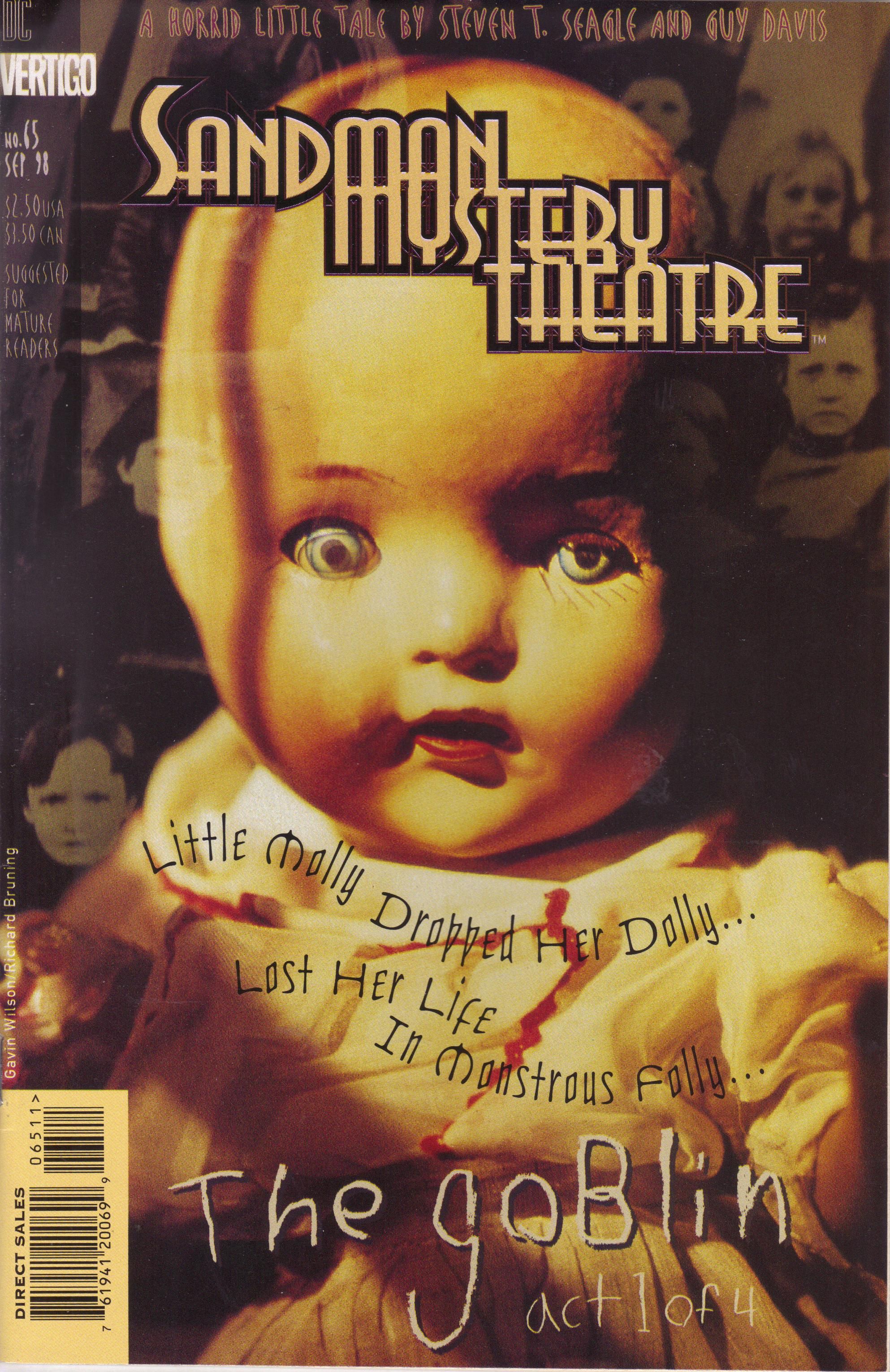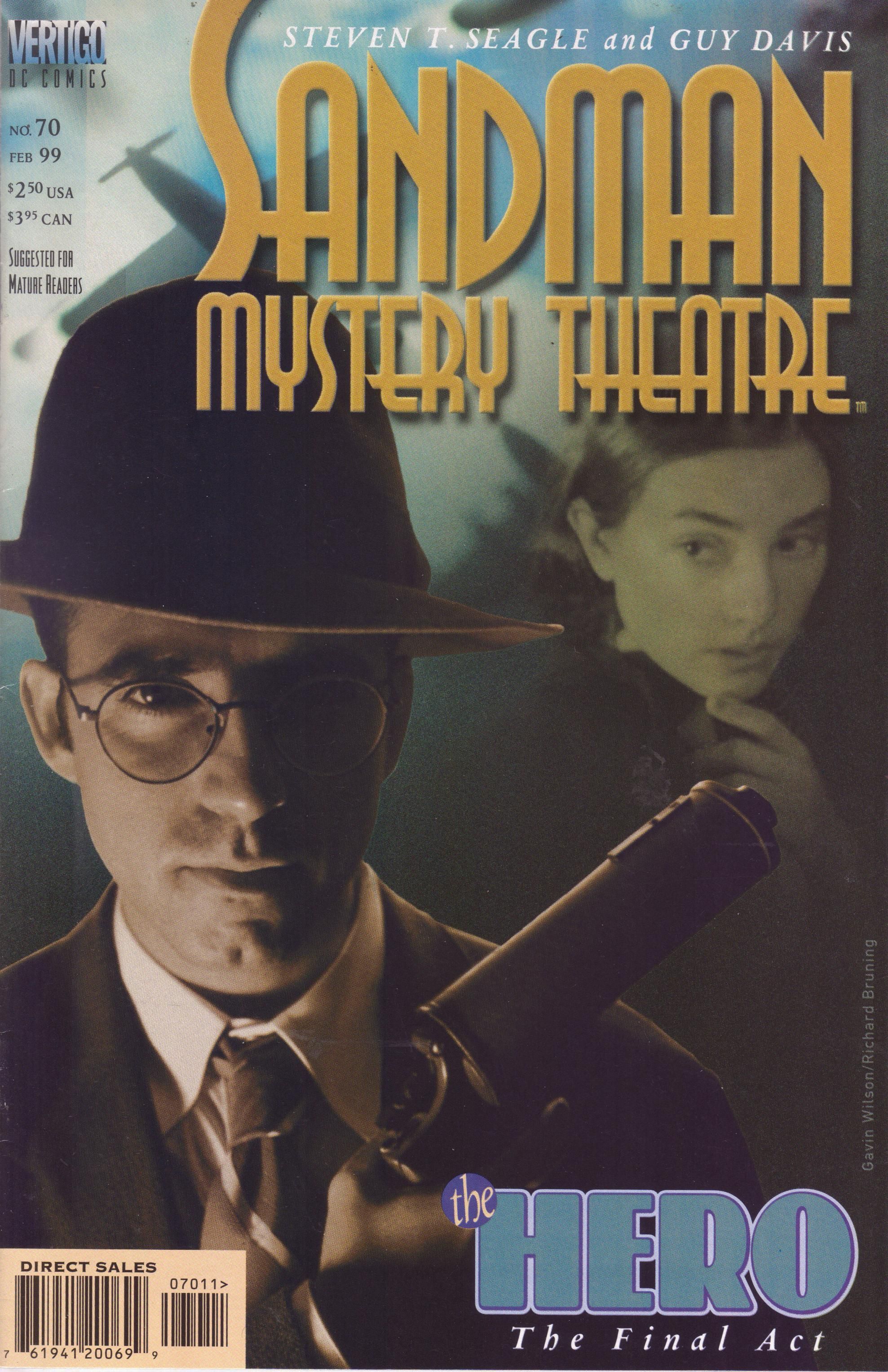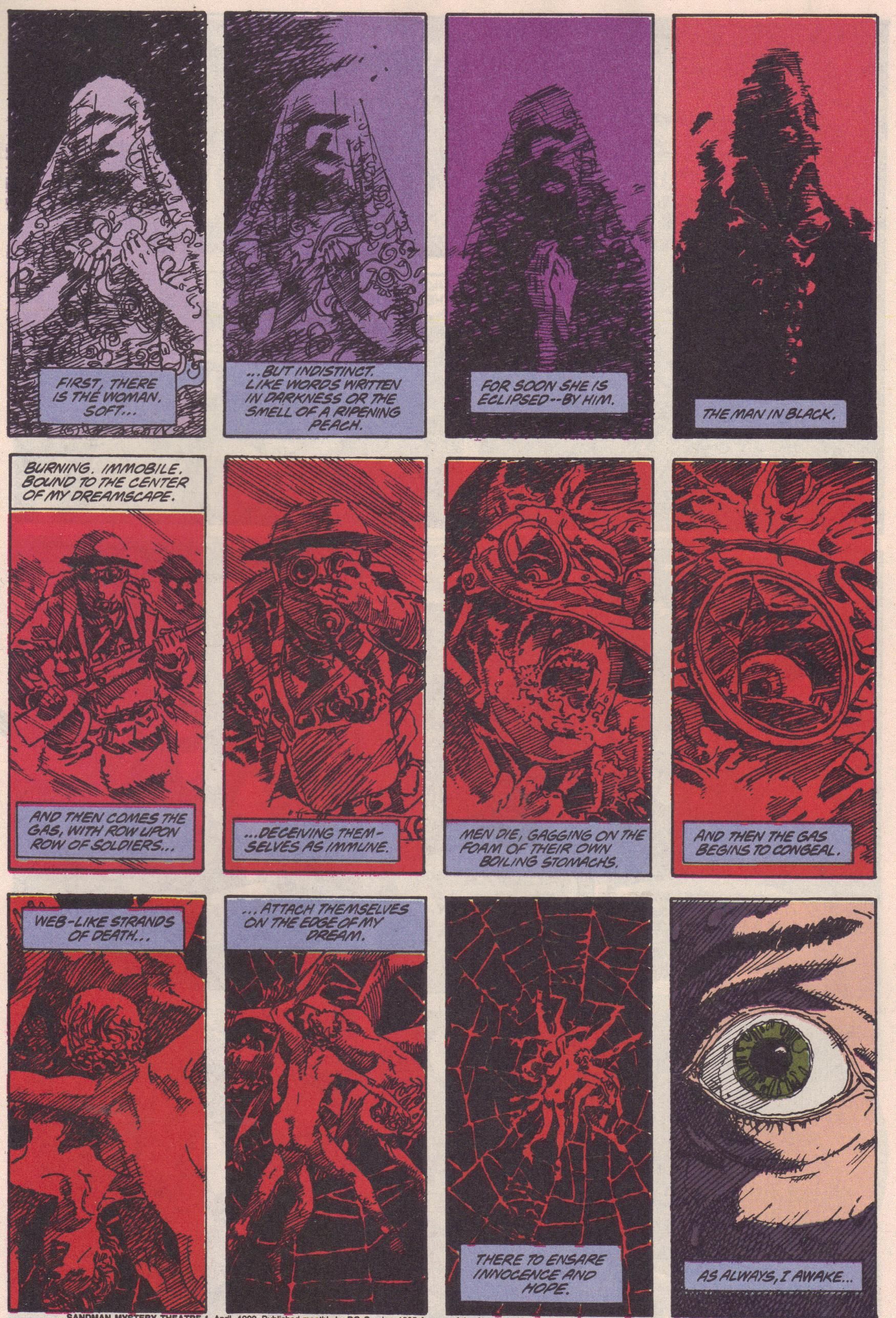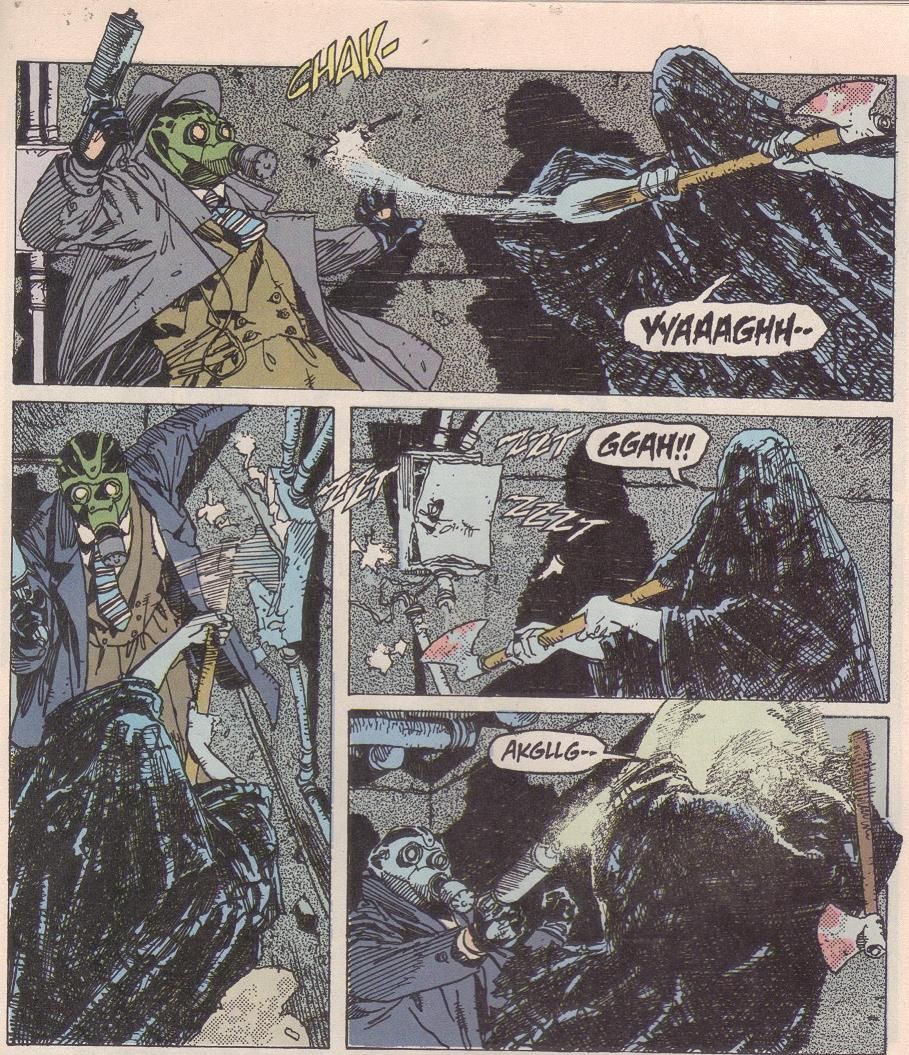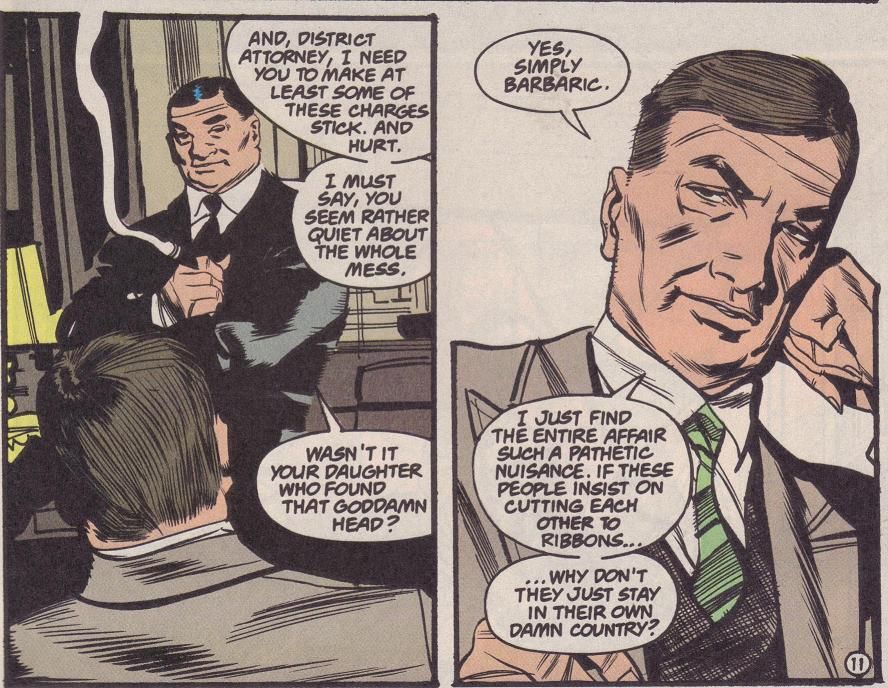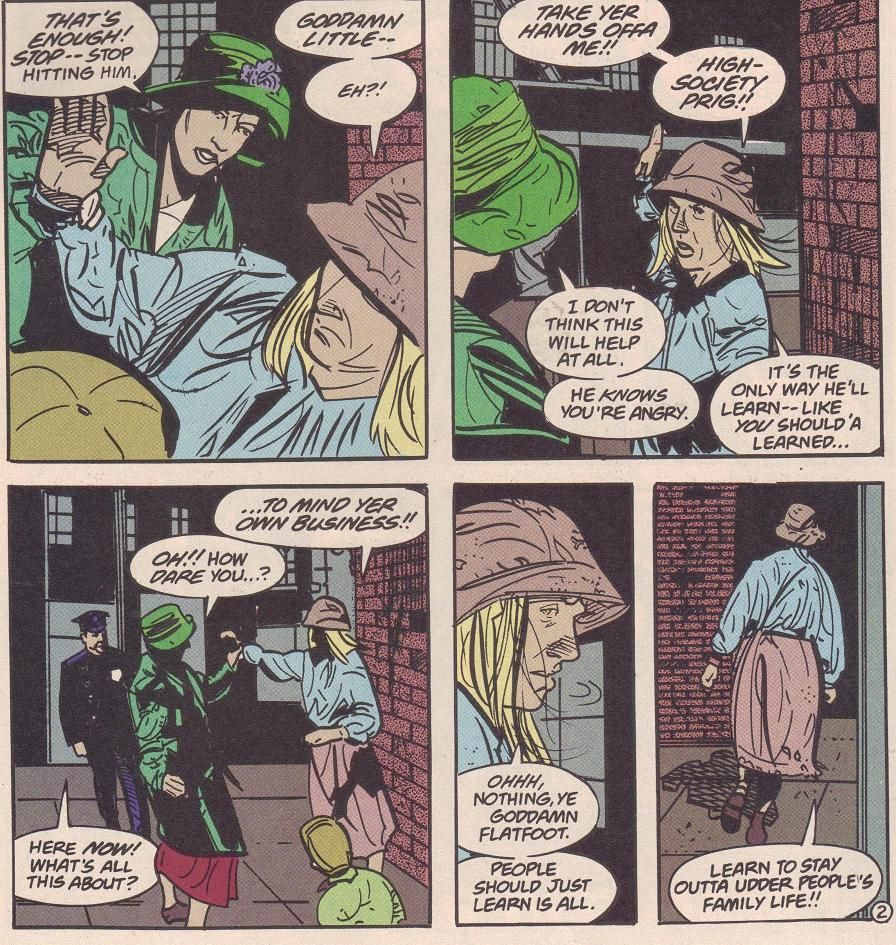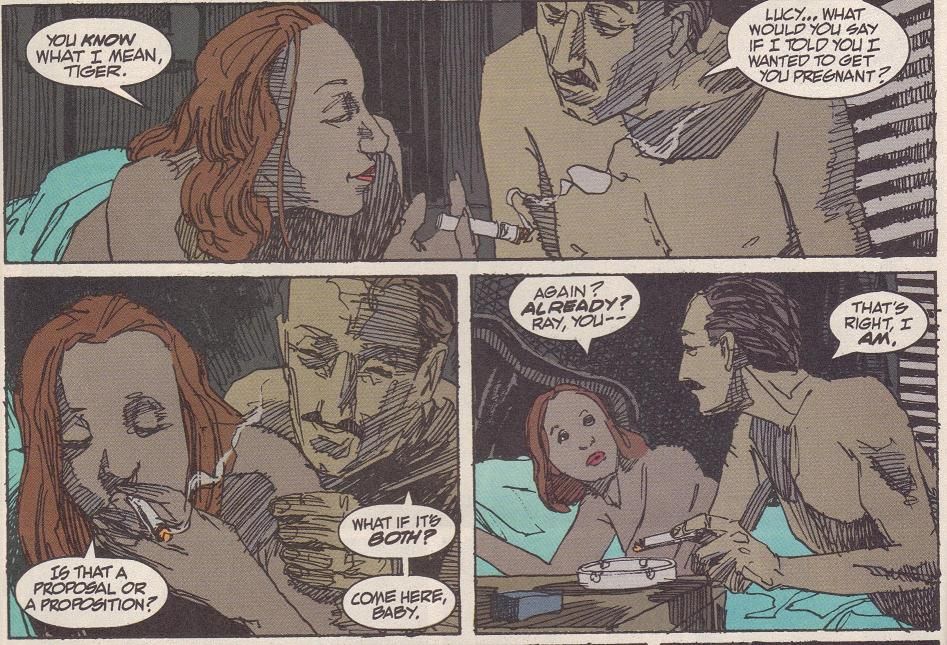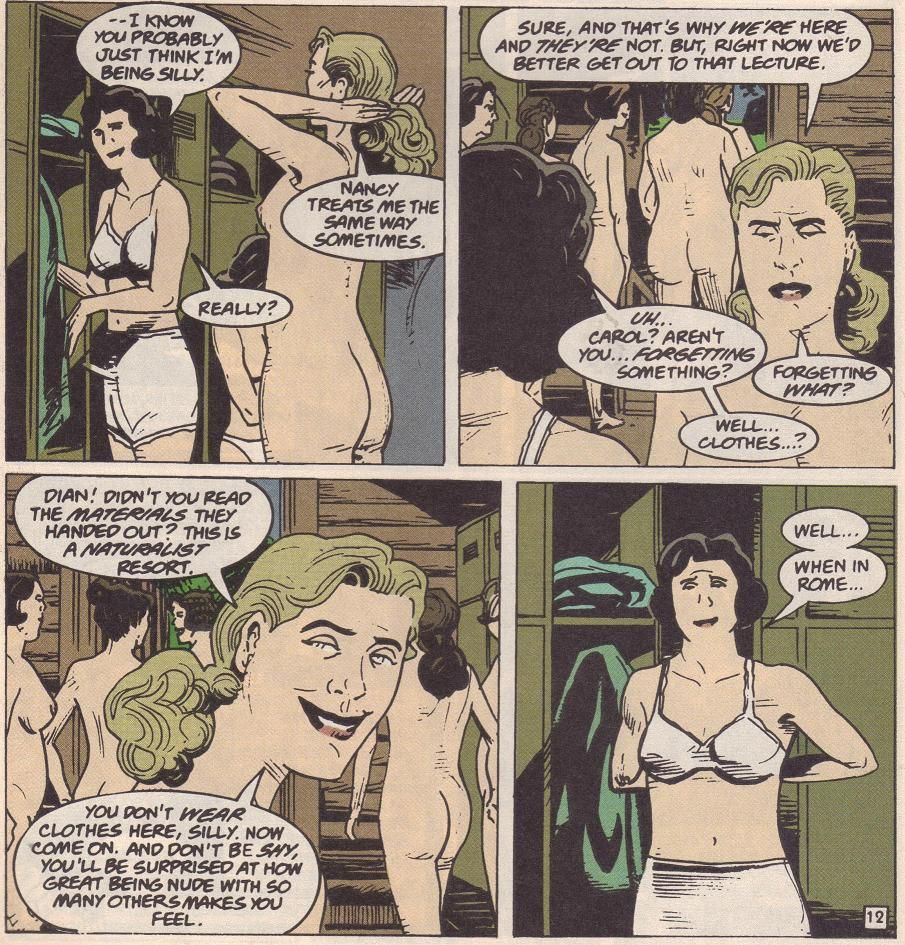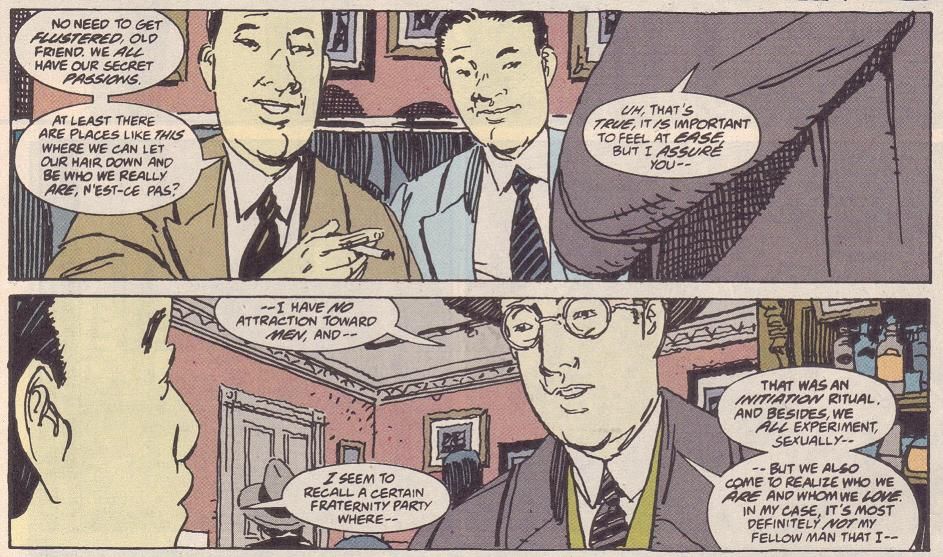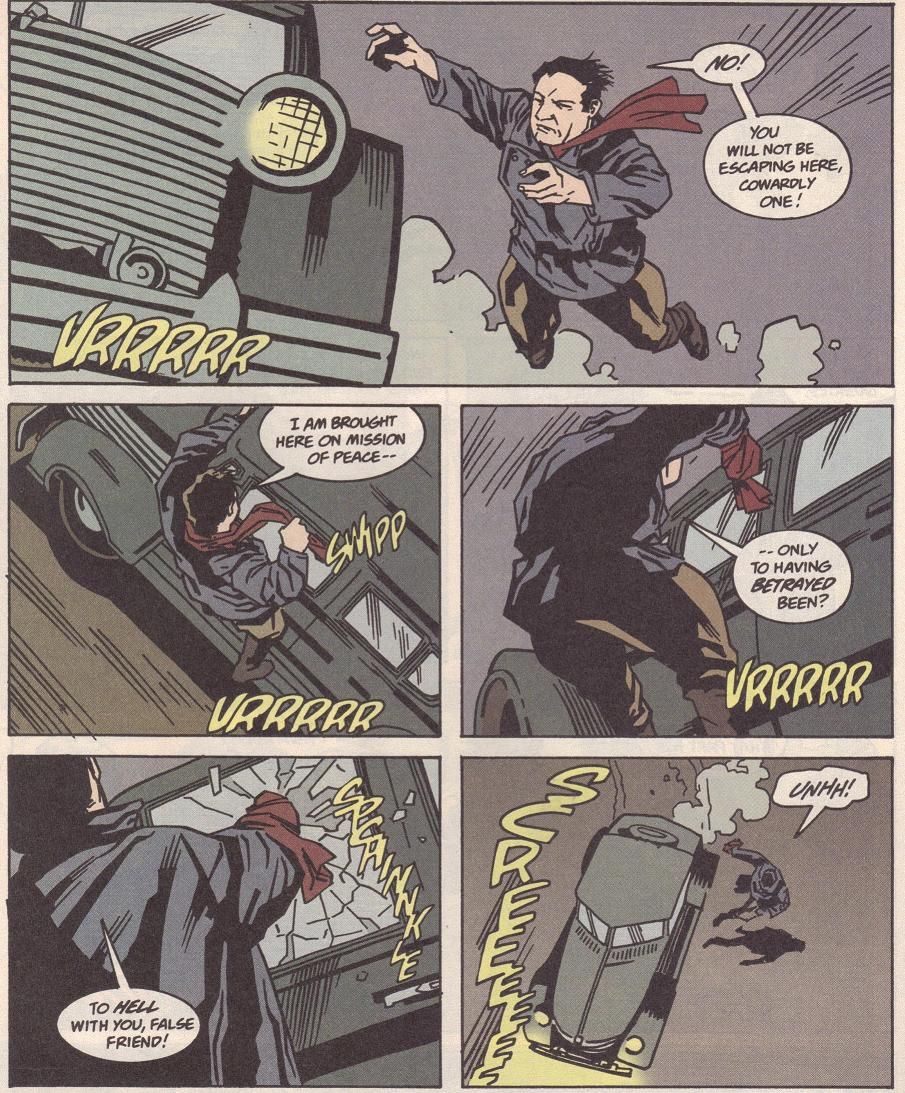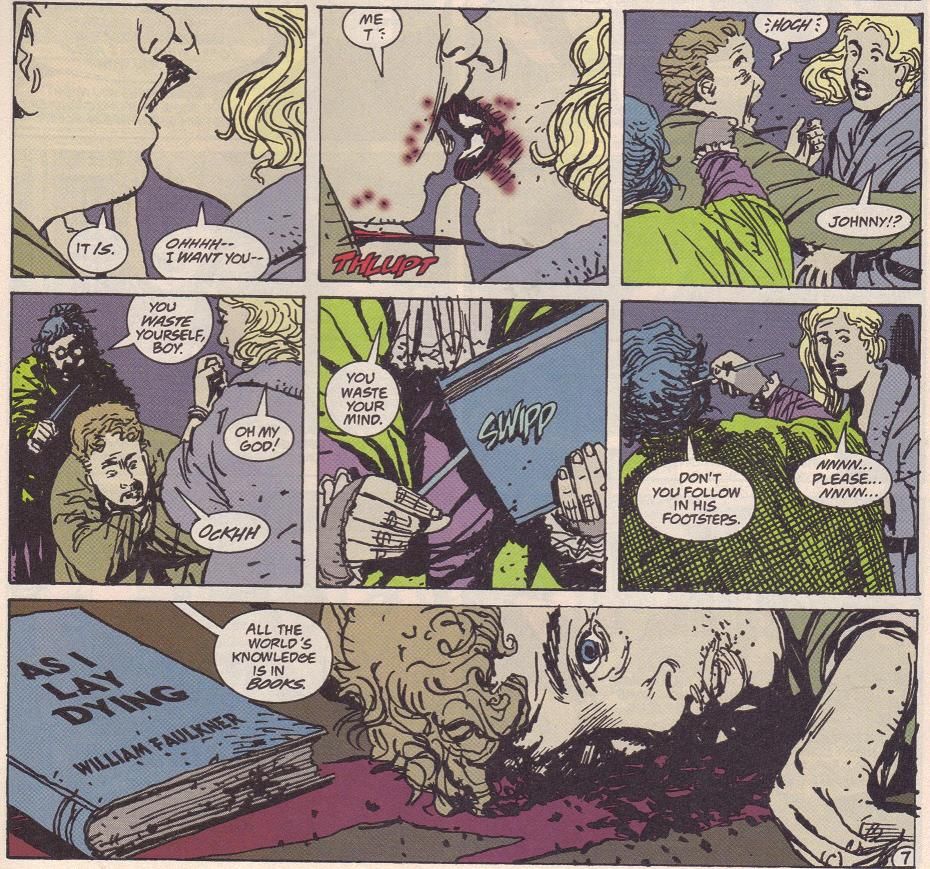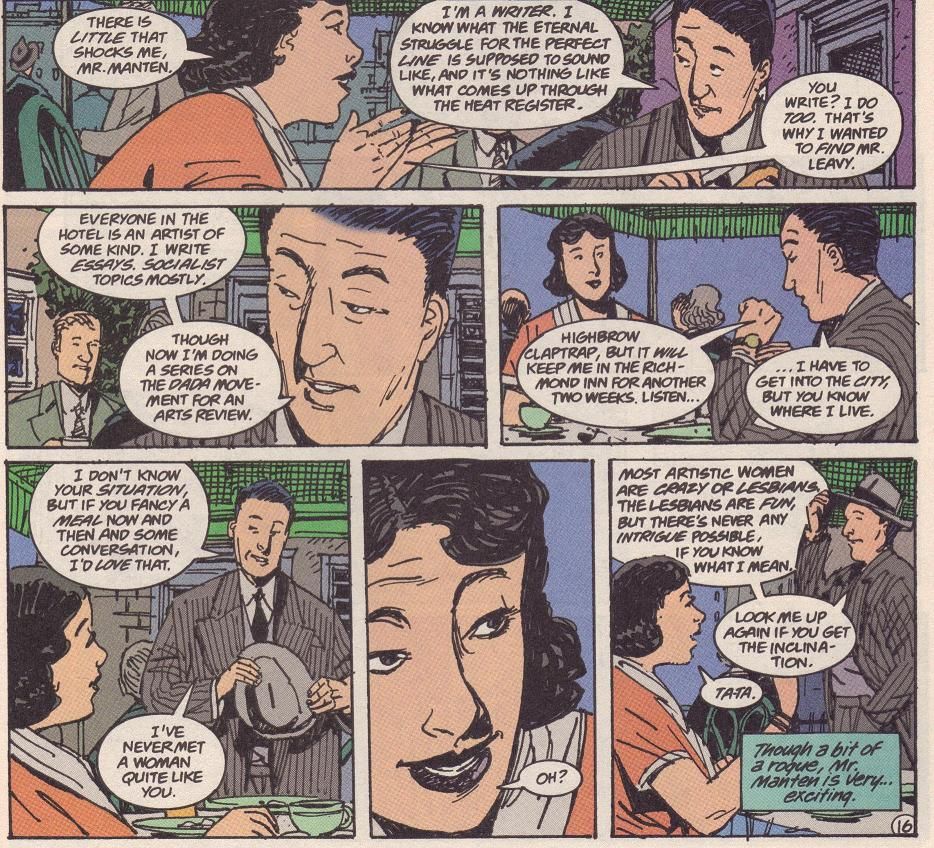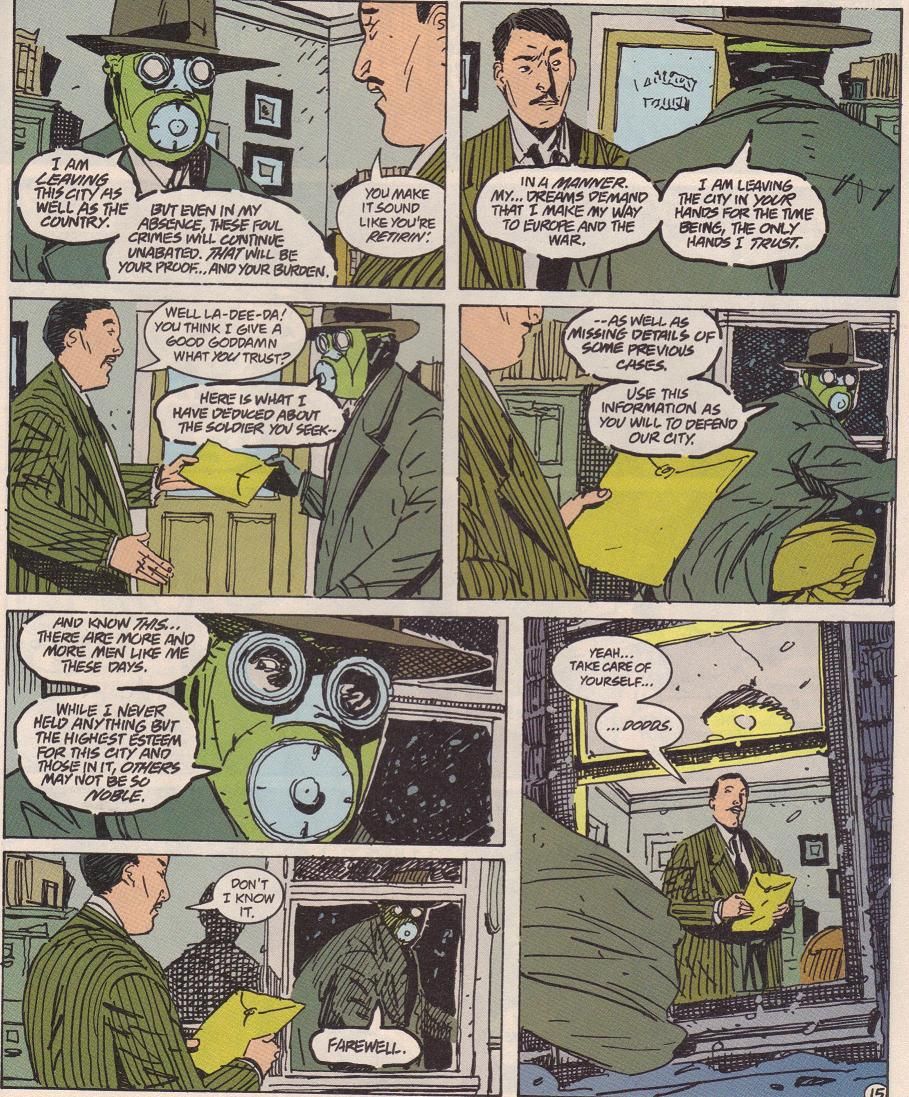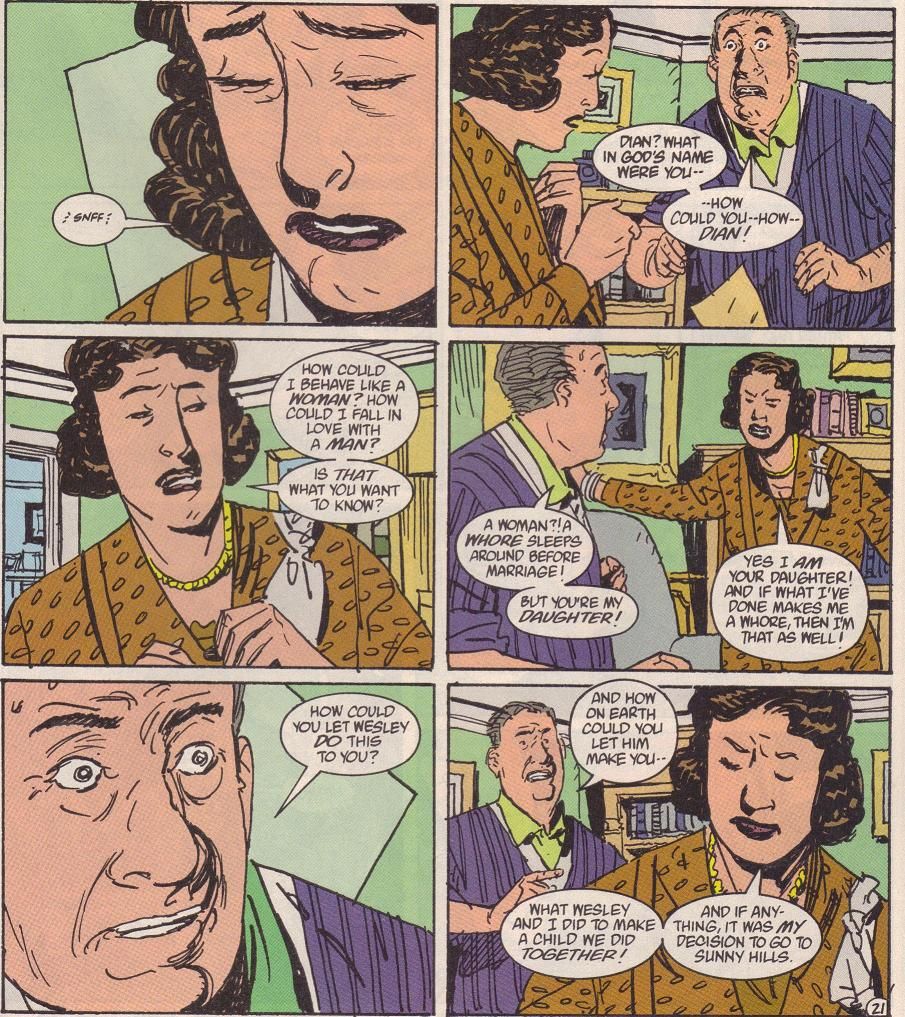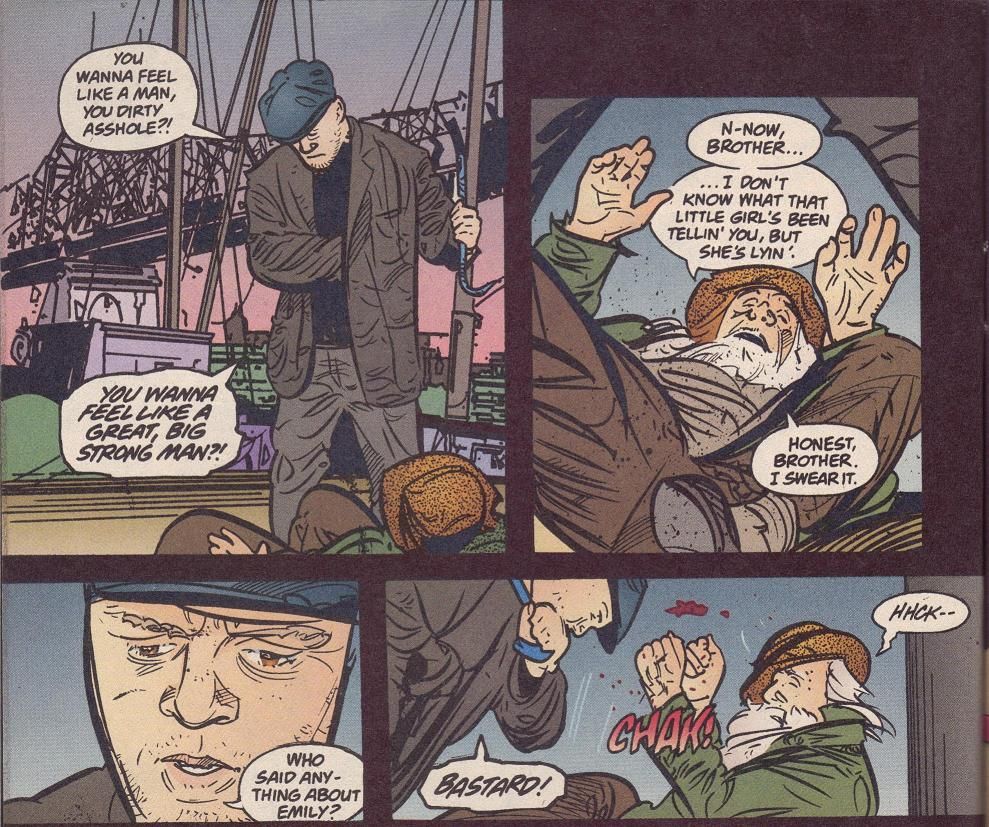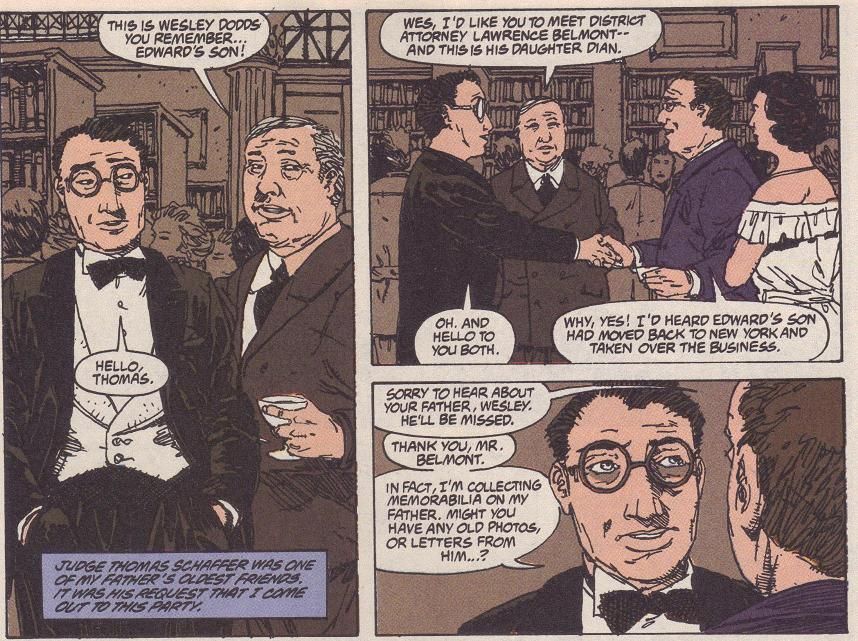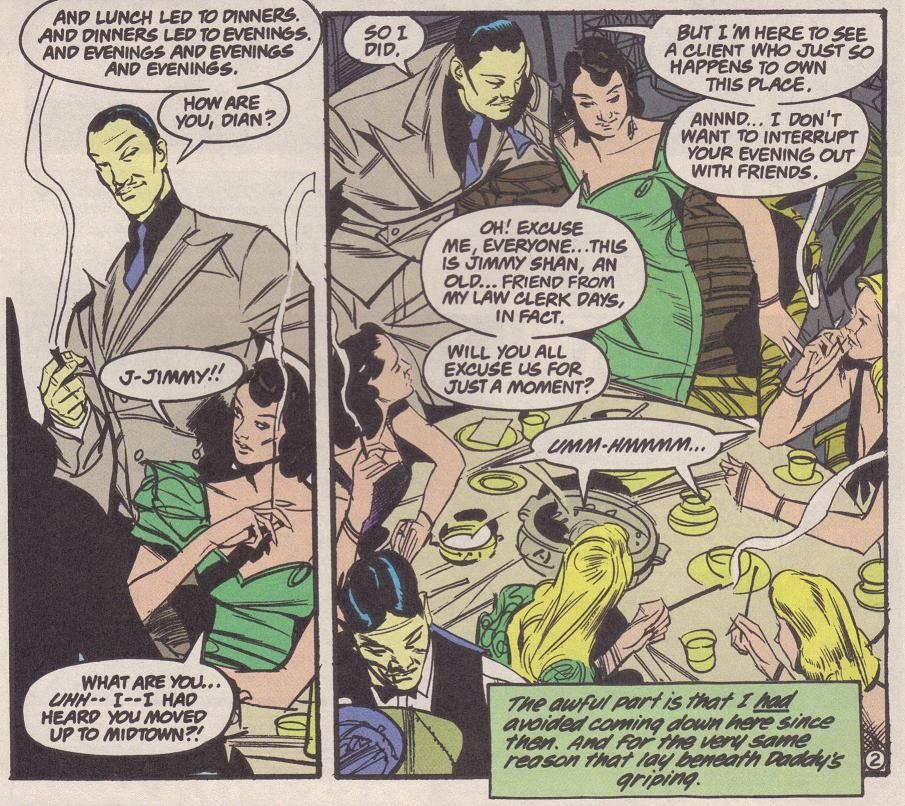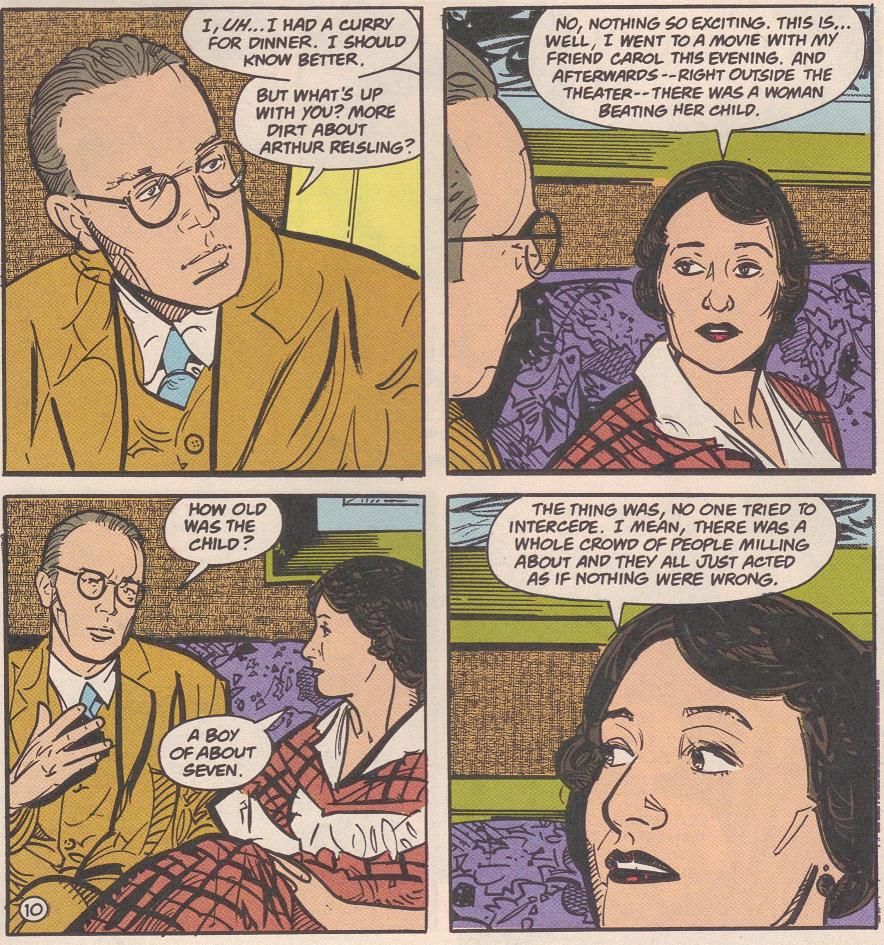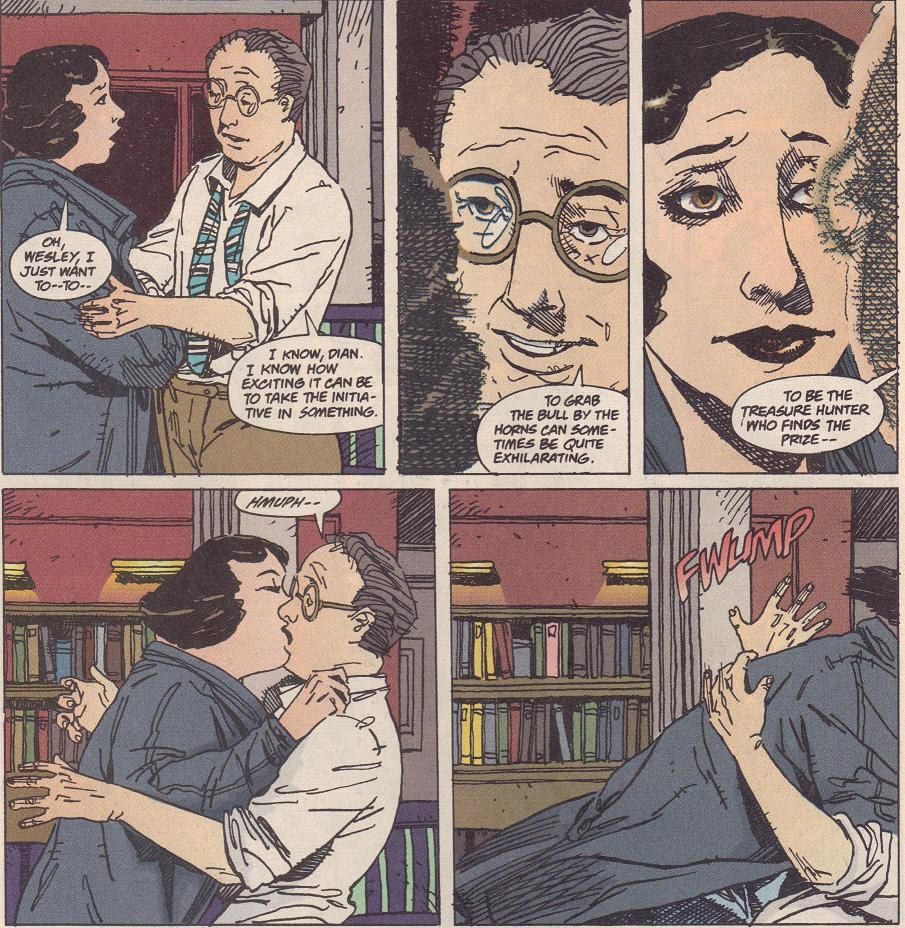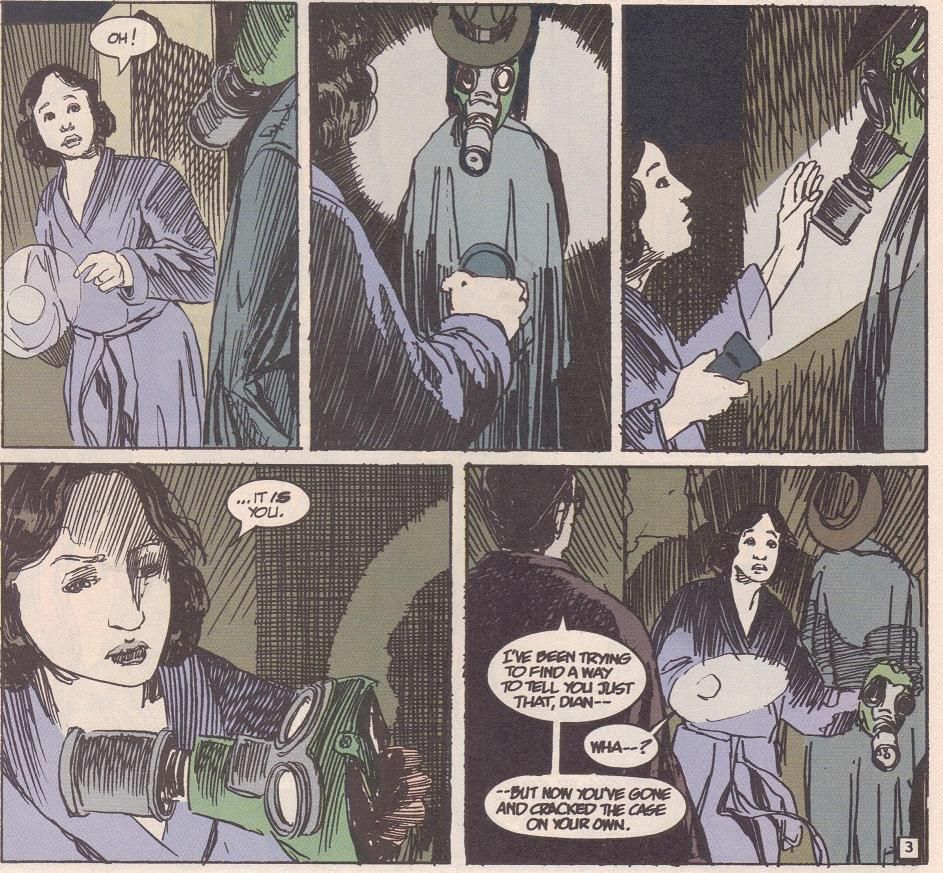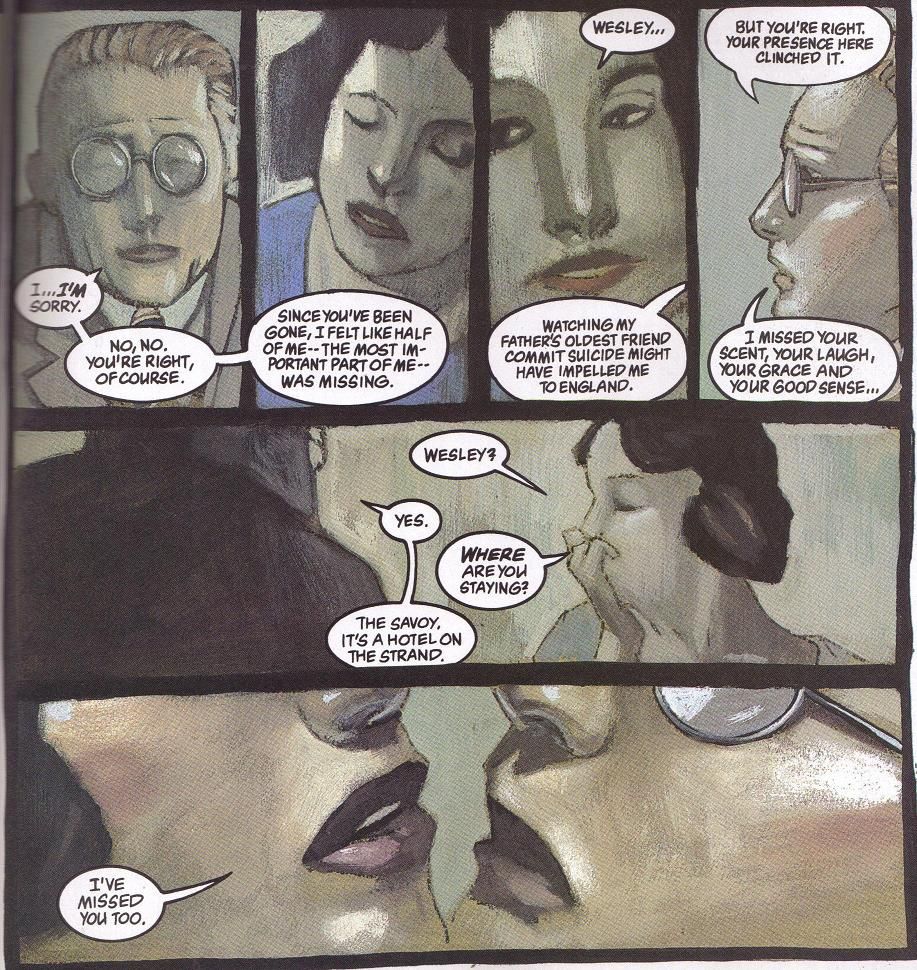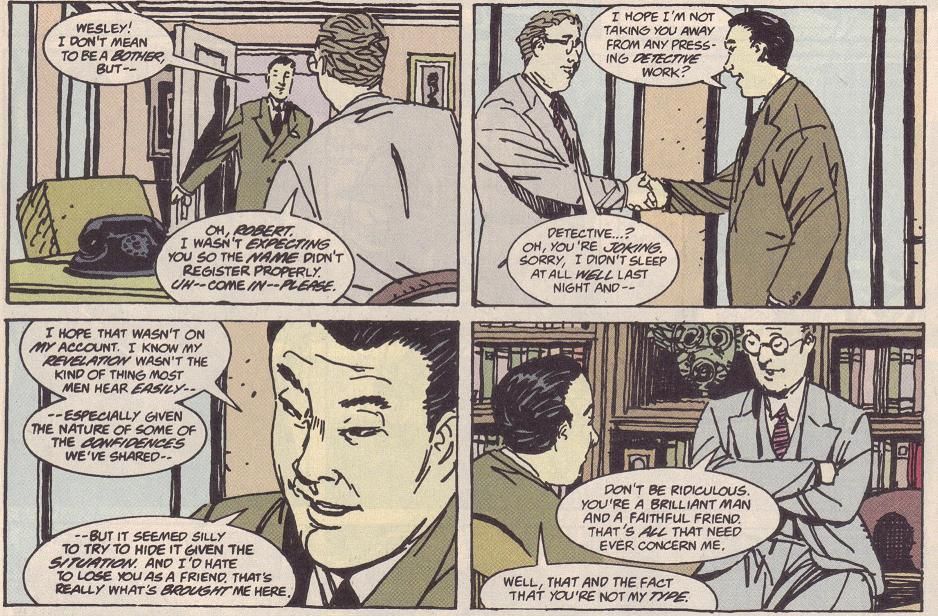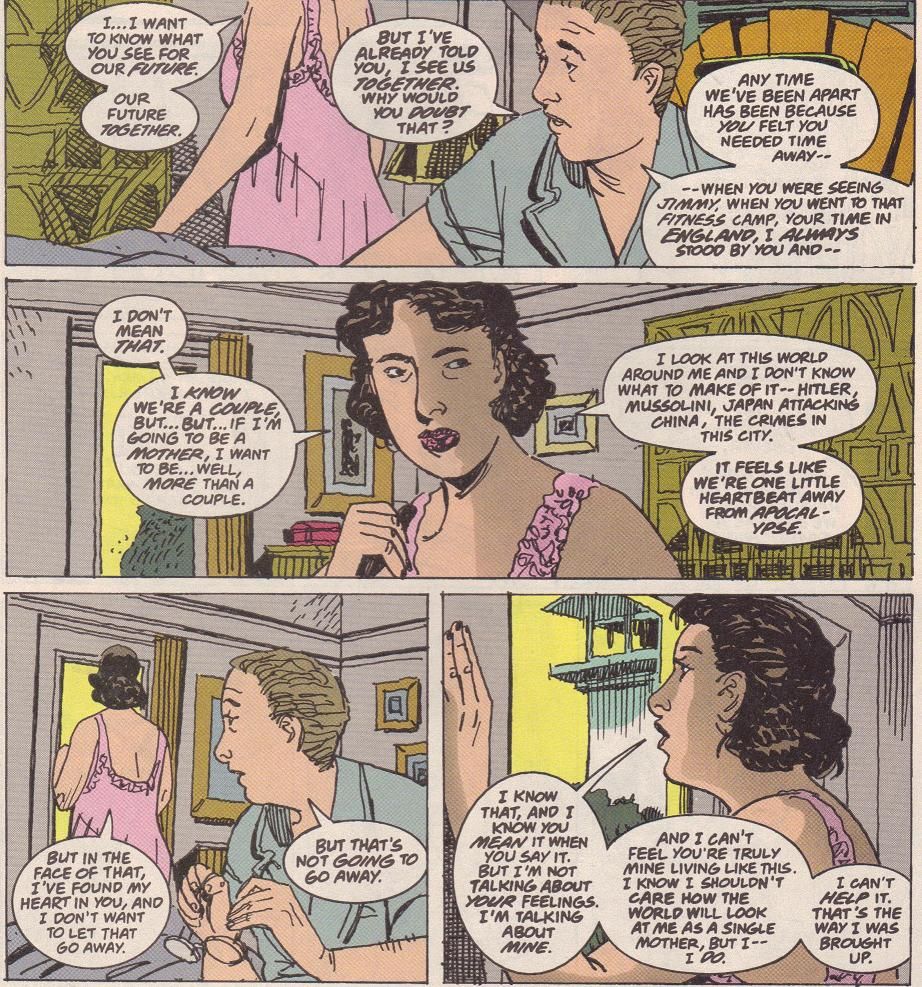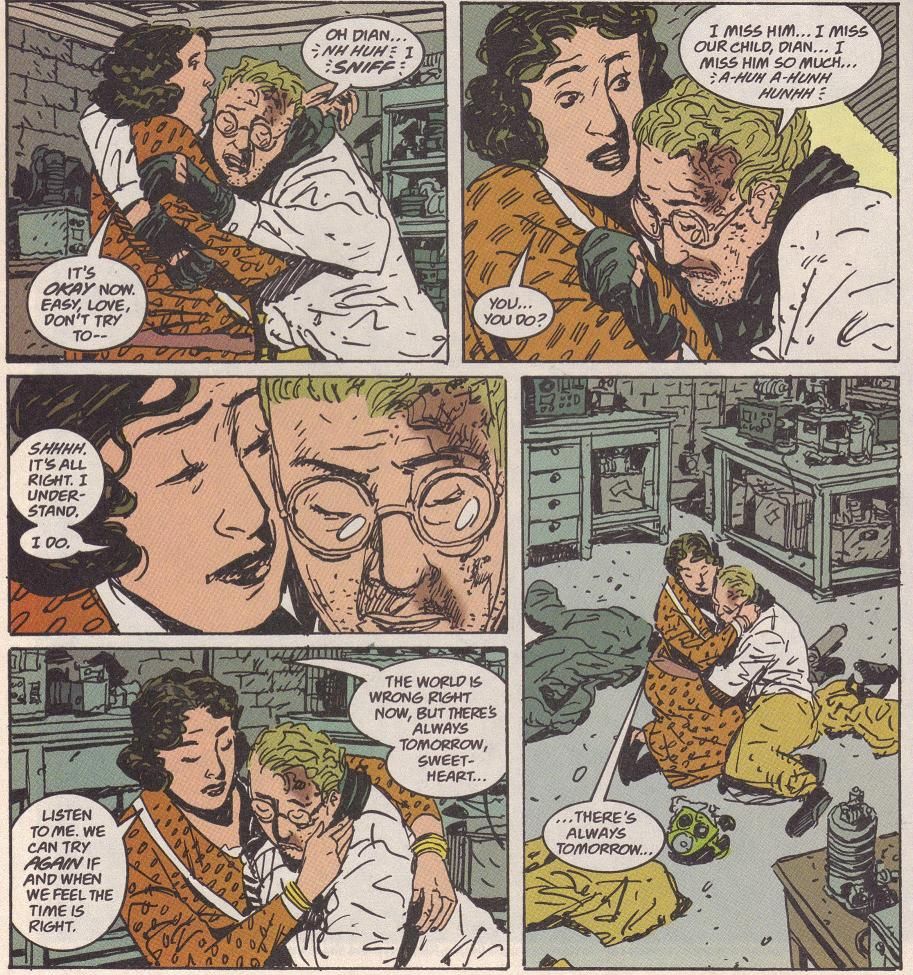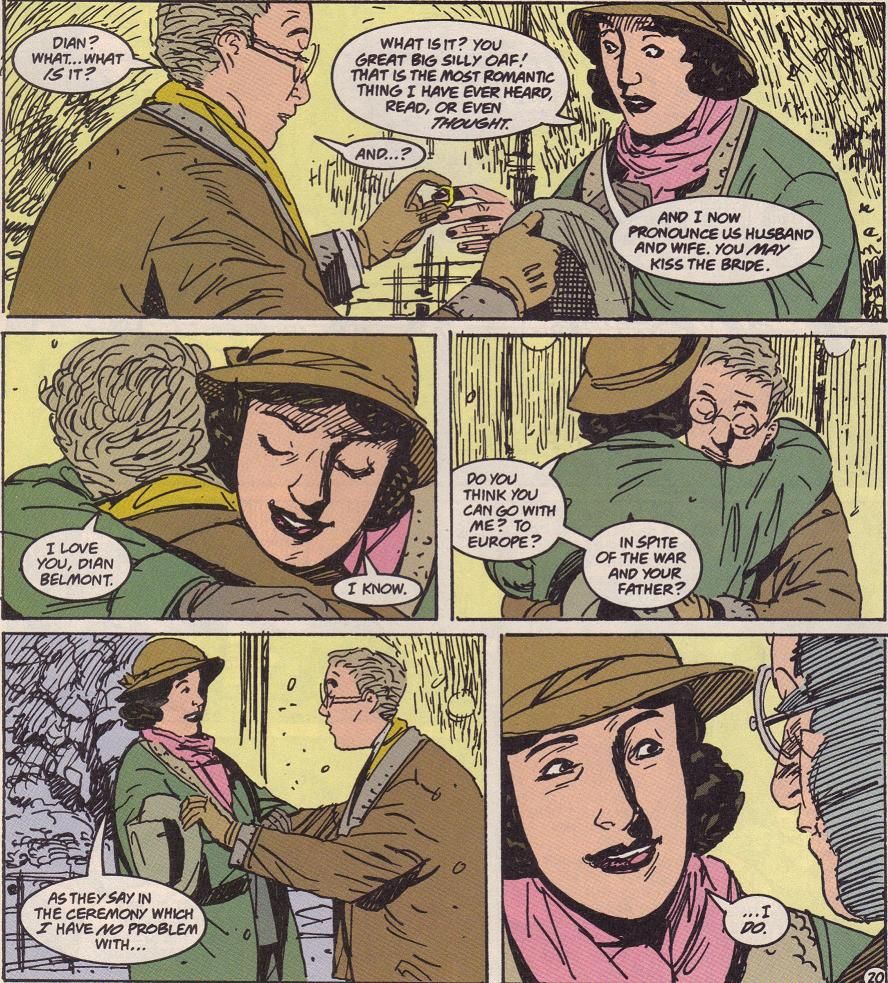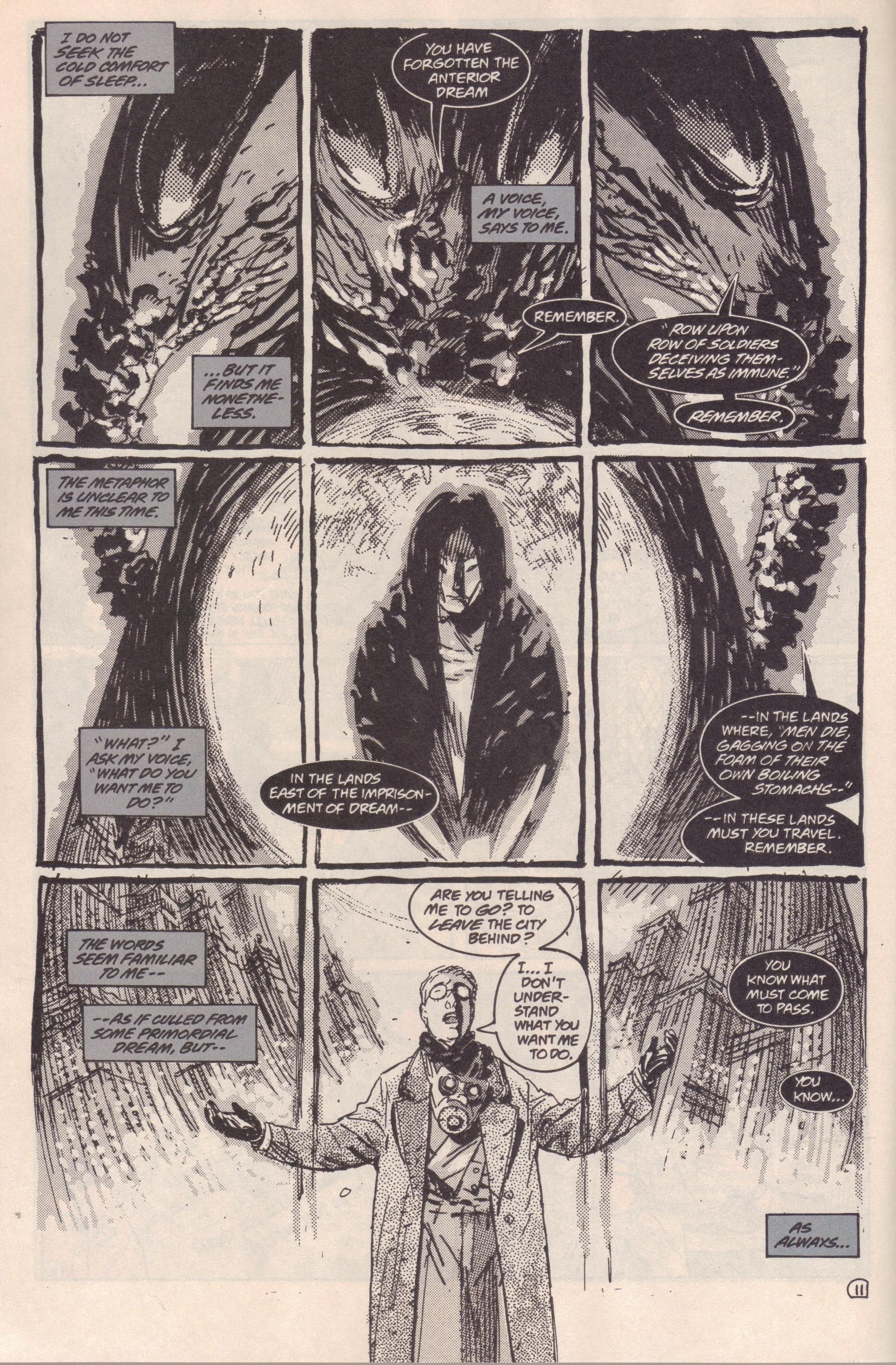The many, many excellent series that begin with "S" continue!
Sandman Mystery Theatre by Matt Wagner (writer, issues #1-60; plotter, Sandman Midnight Theatre), Steven T. Seagle (writer, issues #13-70), Neil Gaiman (writer, Sandman Midnight Theatre), Guy Davis (artist, issues #1-4, 13-20, 25-32, 37-44, 49-56, 61-70; layouts, issues #21-24), John Watkiss (artist, issues #5-8), R. G. Taylor (artist, issues #9-12), Vince Locke (artist, issues #21-24), Warren Pleece (artist, issues #33-36), Matthew Smith (artist, issues #45-48), Michael Lark (penciler, issues #57-60), Teddy Kristiansen (artist, Sandman Midnight Theatre), Daniel Torres (artist, issue #50), Richard Case (inker, issues #46-48, 57-60), David Hornung (colorist, issues #1-70), John Costanza (letterer, issues #1-20, 25-55, 57-62, 64, 66-70), Gaspar Saladino (letterer, issues #21-24, 50, 56, 63), Clem Robins (letterer, issues #65, 67), and Todd Klein (letterer, Sandman Midnight Theatre).
Published by DC/Vertigo, 71 issues (#1-70 of the ongoing plus Sandman Midnight Theatre, which was published after issue #30 but is set between issues #36 and 37), cover dated April 1993 - February 1999.
SPOILERS abound in this post, but not about the actual mysteries. Those I leave unspoiled! I do SPOIL quite a bit about Wesley and Dian's relationship, though, so there's that. Sorry!
The success of Alan Moore in the 1980s and then Sandman for DC had one notable consequence: The "Vertigo-ization" of several of DC's catalog, as writers took old properties, dusted them off, and started writing "mature" stories centered on them. There were dozens of these kinds of stories, and two of the longest-lived and (probably) the most critically-acclaimed were Sandman Mystery Theatre and Shade, the Changing Man.* I'll get to Shade in time, but for now, let's check out Sandman Mystery Theatre, starring Wesley Dodds, the Golden Age Sandman.
* I don't count John Constantine, as he was created to be a horror character and wasn't an old Golden or Silver Age character.
Matt Wagner may or may not have been inspired to pitch the idea of a Golden Age Sandman series firmly entrenched in the "Vertigo" universe by Neil Gaiman, but Gaiman did, in one throwaway panel in Sandman #1, link the imprisonment of Morpheus with Wesley Dodds's nocturnal activities. And so, in 1993, Wagner and Guy Davis began the series, in which Wesley is driven by his dreams to put on a gas mask, shoot criminals with gas, and solve crimes.
He is joined for much of the run by Dian Belmont (who figures out his secret identity fairly early on), his lover and confidante, and opposed by Lieutenant Anthony Burke of the New York Police Department, a rough-and-tumble cop who at some point figures out who the Sandman is but, in contrast to his public persona, doesn't arrest Dodds. Wagner solo and then with Seagle - who joined as co-writer for issue #13, became the main writer on issue #53 as Wagner became the "idea man," and became sole writer after issue #60, when Wagner left the book - wrote four-issue arcs, 17 in all, before Seagle ended the book with a two-issue story, and each story - until the final one - was a precise clockwork, with Wagner and Seagle tying everything together very nicely. This is mirrored in the artwork, with Davis drawing the first arc, Watkiss the second, Taylor the third, and then, with the book's second year, Davis drawing the first two arcs and then a different artist drawing the third, until the final 10 issues, all of which Davis drew. The book marched along, telling fascinating stories and tracking the lives of its characters quite well.
So why does that make it a Comic You Should Own? Well, it doesn't, really. The mysteries in SMT are, honestly, the least interesting parts of the book. They're not bad, certainly, and Wagner and Seagle do tell a lot of different kinds of mysteries, so they remain pretty fresh. The four-part structure allows them to really dig into the mystery and show a lot of different aspects of it. The mysteries revolve around murders, but they're different kinds of murder, with lots of motives and lots of methods, and Dodds solves them in different ways. Yet the mysteries are still the least interesting part of the series.
What makes the mysteries a crucial element is the way Wagner and Seagle tell the story of late 1930s New York. The series begins "four years since the repeal of Prohibition" - which means it takes place in 1938 (Dian says this to her father in issue #1) - and the first time we know the official date is 26 February 1938, when the second arc begins. The book ends rather decisively on New Year's Eve 1939/New Year's Day 1940. In those two years, Wagner and Seagle examine almost every social issue under the sun, all while the specter of war in Europe hangs over the book. The first page of issue #1, the first impression of the series, is Wesley's dream of soldiers dying from a gas attack, and while Wagner clearly meant it to hearken back to World War I, by the end of the book, Seagle has turned it into a premonition about World War II. Over the course of these two years, Wesley and Dian solve cases dealing with all sorts of people. So let's look briefly at each mystery, beginning with the first arc.
"The Tarantula" (issues #1-4) introduces the main characters, including Wesley, Dian, Lawrence Belmont, Dian's father and District Attorney, and Lieutenant Burke. We learn that Dian is at least 25 years old, while Wesley is somewhat older (neither of their ages are ever given). Wesley seemed to be a teenager in 1918, when the First World War ended, so he might be in his mid-thirties when the series begins. We also find out that Dian is quite cosmopolitan - early on in issue #1, she visits a jazz club in Harlem and drinks far too much, which quickly shows that she is far from a traditional woman. The case is very pulpy, perhaps the most pulpy of the series.
It involves gangsters and incest, and it showed that Wagner was going to show both the high-end culture of the city and its vicious underbelly. Wagner doesn't really get into many societal issues, except to show that Dian pushes against them.
"The Face" (issues #5-8) begins the examination of various cultural and societal issues in the city, as Wagner takes us into the Chinese underworld in New York. We discover that Dian and Jimmy Shan, a member of the Tongs, were once on intimate terms. It's an interesting story, because Dian obviously has prejudices that she wants to overcome (unlike her father, who doesn't care to overcome them), but Jimmy himself is also in the grip of prejudices. The murder mystery is almost secondary to the "star-crossed lovers" aspect of the story - even though Dian and Jimmy don't rekindle their romance, Wagner writes them almost as a couple, two people who can't quite move past their pre-conceived notions of each other. There's also an interesting scene where Dian and a friend talk about the jitterbug, and Dian is already old enough to think the dance is a bit silly. Wagner and Seagle are usually more blatant in their generational conflicts, but Wagner shows in the brief scene that even someone as young as Dian can feel old and out of touch.
In the next arc, "The Brute" (issues #9-12), Wagner gets into the world of illegal boxing, tying that into the enormous economic disparity that existed during the Depression. One of the characters in the story has a young daughter, who is sexually abused during the course of the arc, and Wagner does a nice job paralleling this to Dian and Wesley's nascent relationship, which begins hesitantly in this arc. This is also the beginning of Dian's social conscience, as she begins to understand that not all parents are suited for the responsibilities that come with children.
This foreshadows both her charity work in the final 4-issue arc, "The Goblin," and her pregnancy and her fears about her own inadequacies as a parent. The title character turns out to be an abused child as well, and Wagner does a pretty good job keeping it all tightly focused on this issue. The predicament of Emily - the girl who is raped - is a bit melodramatic, but it's still effective.
"The Vamp" (issues #13-16) is a controversial story mainly because Wagner and new co-writer Seagle bring 1930s lesbianism to the forefront, and some readers didn't take kindly to what they saw as the stereotypical portrayal of gay women. The critique has some merit, but only because, often, when minorities are presented in mainstream fiction, they take on the burden of being the exemplar - they can't just be people because they're the only representative of that minority, so they must embody the entire experience of the group. Wagner and Seagle don't often fall into this trap, even though minorities in SMT are often introduced and dismissed as they fit the case, and I don't believe they do here. There is a cadre of lesbians who seem stereotypical in "The Vamp," but the writers do a fine job introducing several different characters, so they can encompass the lesbian experience, circa 1938, without worrying that one of them is evil. They show different sides to being gay in a time like the 1930s, where one lesbian knows she has to hide who she is while others can be more open, not because they're necessarily more confident and brave, but because they're a higher class than the other. This is a crucial part of Sandman Mystery Theatre - class is always in the background, and the women in "The Vamp" act the way they do primarily because they're in a high social class. But, as Wagner and Seagle point out, this also constricts them, as the lower class lesbian is free (although closeted) while her lover is expected to marry a rich man, and she certainly can't escape that fate. It's also noteworthy that Dian is more comfortable with the women than Wesley is in a later arc, when homosexuality is a key aspect of the case.
In "The Scorpion" (issues #17-20), Wagner and Seagle get into the culture clash between the urbane New Yorkers and the rural Texans, but they also bring in war profiteering, as Wesley is approached by a group that wants to get into foreign oil just when Europe is desperate for it. This leads to another clash of classes, as it appears the killer in this arc is personally affronted by people with wealth. The reason for this I won't spoil, but it's just another way for the writers to introduce the division of classes in the 1930s.
Issues #21-24, "Dr. Death," deals with the idea of physical perfection and beauty and the darkness that can lurk behind that ideal.
The killer does away with people that he thinks are either too old or not good enough to function in society, and given the context of what's going on in the world at the time, it's clear that Wagner and Seagle are linking this to the Nazis and their pogroms. The story also concerns sex, as Dian's cousin is having a lot of it, while Dian wonders is Wesley is really all that interested in her. By the end of this arc, Dian is questioning her relationship with Wesley, which leads to their temporary break later in the series.
The case in "The Night of the Butcher" (issues #25-28) is almost incidental. There are a series of horrific crimes, but the real focus on the story is Wesley and Dian's evolving relationship and Lieutenant Burke's chase of the Sandman. Burke discovers that Wesley has bugged his office in issue #26, and when the two men track the Butcher to his lair, they need to work together even though Burke would like better to shoot the Sandman. This arc also introduces Robert Li, who would return in a later story.
Wagner and Seagle introduce another Golden Age hero in "The Hourman" (issues #29-32), when Wesley meets Rex Tyler. The case is a fairly typical scam, but the story does show us once again that Wesley uses his business interests to investigate certain unusual occurrences that the Sandman might be curious about. The story comes to a climax on New Year's Eve, so the book moves from 1938 to 1939.
Physical fitness is a major component of the next mystery, "The Python" (issues #33-36). Dian gets interested in the fitness regimen of Jake Bonoir, who's obviously supposed to be an analog for Jack LaLanne. Bonoir's fitness camp upstate is very cult-like, and when Dian gets there, she realizes she's expected to go nude for most of the activities. It's just another example of Dian's free-spirited nature - she likes to try new things, but when she almost has a lesbian encounter (for the second time in the series, mind you), she pulls back.
She's not quite that adventurous! On the first page of the arc, Wagner and Seagle cleverly link Bonoir's fitness program to Nazism quite subtly - it's not as horrible as Nazism, of course, but there's an element of fascism to Bonoir's program, which becomes ironic later in the arc. As usual, the war continues to cast a dark shadow over the series.
Sandman Midnight Theatre was released during "The Hourman" arc, but chronologically, it comes after "The Python," as Dian receives a letter from an old friend who lives in England and sails there to sort out her feelings for Wesley. Of course, Wesley ends up in London too, investigating a case of blackmail that drove a friend of his to suicide, but Dian thinks he came after her. Wesley and Dian end up at Fawney Rig, where Wesley has a brief encounter with Morpheus, trapped in his glass prison. The story is noteworthy for introducing Reverend Armitage Hawsley, who moonlights as a thief called the Cannon (it's a pun!). He shows up in a later arc.
"The Mist" (issues #37-40) tells the secret origin of Starman's arch-nemesis. This was part of an interesting "non-crossover" where the 1930s Sandman came across the Mist, while in Starman, Jack Knight met the old Wesley and Dian. Jonathan Smythe is a scientist who creates a machine that turns things into mist, but he needs funding to continue his research. He tries to sell his invention to the U.S. military, but fails. While he experiments, he works for the mob, who's having some trouble with sailors not using the union to unload their cargo. This is a nicely-plotted story (they all are, but Wagner and Seagle have a lot of balls in the air in this one) - Smythe destroys a ship that kills an old German man, and his surviving son is treated poorly by the police, which drives him into the aegis of a Nazi fifth column in New York. Smythe is contracted to kill a rabbi, and although he screws up the job, coincidentally, Fredric, the young sailor, is ordered to kill the same rabbi - but Wesley is there to stop him. The gangsters turn Smythe's machine on him, but he manages to escape before it kills him, although it does make his body somewhat vaporous, which of course makes him a supervillain. Fredric disappears after the Sandman gasses him, and I can't help wonder if the writers planned to bring him back later on but the book's cancellation precluded that. As part of the romantic subplot that runs throughout the series, Wesley meets Ted Knight, who charms Dian (although that's as far as it goes). Knight is a good contrast to the more subdued Wesley, even though Wesley and Dian continue their rekindled affair as the arc moves along.
Wagner and Seagle use the World's Fair of 1939 as the backdrop for "The Phantom of the Fair" (issues #41-44), in which Wagner and Seagle examine gay culture much like they did with lesbians in "The Vamp." In this arc, we learn that Wesley's old friend, Robert Li, is gay, which causes Wesley no small amount of psychological soul-searching. He claims to be fine with homosexuals, but when he's confronted with a friend who is, he's not quite as liberal as he'd like to believe. This doesn't last long - Wesley is open-minded, after all - but it's handled well by Wagner and Seagle, because they remind us that even a man like Wesley can be thrown by a revelation like that - it's still 1939, after all. Also of interest is the fact that the organizers of the Fair try to keep it quiet because they don't want bad publicity, which is a clever idea by the writers. The arc is notable because there's a cameo by Jim Corrigan and a brief but violent appearance by the Crimson Avenger. Wagner and Seagle continue to do a nice job embedding this in DC's Golden Age without being too obnoxious about it.
The war is front and center in "The Blackhawk" (issues #45-48), as Janos Prohaska (which is what Howard Chaykin named him) comes to America to ask for funds to help the Poles fight the Nazis. This story takes place after May 1939, as the news mentions Hitler's alliance with Mussolini "in May of this year."
Someone is trying to frame Prohaska, who happens to be connected to a series of murders. The motive turns out to be fairly mundane, but Wagner and Seagle do tie the larger story into the coming war. Meanwhile, Lieutenant Burke has a personal interest in the case because the first victim is a prostitute with whom he had a long relationship. As the series moves along, the writers humanize Burke quite a bit, and this is part of that process.
The next arc, "The Return of the Scarlet Ghost" (issues #49-52), allows the writers to have some fun with the metafictional aspect of the series. The Sandman has become a character in a pulp magazine, and the publisher of said magazine gets involved in a turf war with another publisher. Wagner and Seagle take a look at the immigrant experience to a degree, as three Irish thugs are involved, but a fourth - one of the thug's brother - is an artist working for the magazine, and it's interesting to see how they react differently to living in America. Wesley and Dian's relationship reaches a crucial point, too, as Dian is injured when a bomb explodes at the magazine's offices - she was trying to sell a story but had been rejected because she was a woman. While she's in the hospital, she confesses to Wesley that she's pregnant, which the writers had been implying for some time.
"The Crone" (issues #53-56) is another story about the entertainment industry, as this time the crimes are committed against members of a radio show, and the main suspect is a woman who loves books and thinks radio is destroying culture as we know it. Obviously, Wagner and Seagle are making a point about modern entertainment and what constitutes "classic" art, but that's not really the important part of the story.
Two women have abortions in this arc, with the radio actress's foreshadowing Dian's decision to terminate her pregnancy. She makes the decision partly because Wesley refuses to marry her, as he feels it's an antiquated tradition. When she tells him, however, he reacts strongly against it before deciding that he should support her. The arc ends with Dian meeting the nurse who will accompany her to the abortion clinic. There's also a cameo in this arc by Charles McNider, better known in DC lore as Dr. Mid-Nite (although Dr. Mid-Nite didn't appear until 1941, so presumably McNider hasn't become a superhero yet).
Armitage Hawsley, known as "Bagsy," returns in "The Cannon" (issues #57-60). The story again touches on the trouble in Europe - there's a scheme about rogue SS officers stealing gold from Poland and trying to sell it in New York, and Bagsy got involved through a Polish family whose gold was stolen by the Reich. It's a fairly convoluted plot that involves 1933 Double Eagle coins and a Nazi spy who's trying to reclaim the gold for the Reich. Bagsy figures out that Wesley is the Sandman, too, which perhaps foreshadows the end of the series, when Wesley decides to give up his costumed lifestyle - is it getting too dangerous? The war provides more foreshadowing, too - Wesley has always been concerned about the Nazis' growing power, and this is another step along the way to his decision in issue #70.
Wagner left the book after "The Cannon," and in "The City" (issues #61-64), Seagle tries something different: each issue tells a different story, focusing on one character in one New York borough (excluding Manhattan, which is the setting of every other story). Wesley solves a crime in the Bronx, which is the least interesting of the stories.
Dian visits an artists' colony in Staten Island in search of an elusive author, and she meets a dashing rake, Richard Manten, who stirs her passion a bit. Manten becomes important later on in helping get Dian's first book published, but in this issue, he's just interested in getting into Dian's pants. Wesley's manservant, Humphries, gets the spotlight in issue #63, as he discovers that his daughter has been making stag films in Queens, and he goes to rescue her. Etta has joined the Communist party (she expressed sympathy with communist views earlier in the series), and to help raise money for it, she's appeared in softcore porn movies. The story probably could have been expanded a bit, as Etta seems to asquiesce to her father's rescue fairly easily, but it's still a nice tale about what a father will do for his daughter. Lieutenant Burke is the star of the final issue of the arc, as he solves a crime in Brooklyn. The main focus of the story, however, is his budding romance with Doris, a fellow cop's sister-in-law. In the latter stages of the book, Seagle chose to mirror Wesley's somewhat bumbling romantic overtures toward Dian with Burke's more grand gestures, and this issue sets that up a bit.
The final 4-issue arc, "The Goblin" (issues #65-68), brings together several threads as the series moves to its conclusion. Dian volunteers at an orphanage, but realizes that she can do more work at a far seedier one. Both orphanages, it seems, are somehow involved in the main case, which is about child kidnapping. Wesley, however, is beginning to crack - he spends his nights sitting in his costume, waiting for something to happen, and early on in the arc he is seriously injured and obviously sustains some damage to his head, which causes him to wander around gassing people for no reason. Dian's father, meanwhile, finds out she had an abortion, but while he's arguing with her, he has a heart attack. She also meets with the writer, Richard Manten, who tries to help her sell her manuscript ... and also kisses her, making her even more confused. At the end of the arc, she manages to get Wesley out of his mask, but he's overcome with despair because of Dian's abortion. All of this leads to his decisions in the next arc, which wrap up this part of his life.
"The Hero" (issues #69-70) feels a bit rushed, and it's unfortunate that Seagle couldn't go out with a 4-issue arc. The villain is dressed like a World War I veteran, but he's only there to remind Wesley of other things. He receives a letter from his brother, who is now trapped in Poland. This spurs him into action, but not before he wraps things up in New York. He finally marries Dian, who accompanies him to Europe even though she manages to sell her manuscript. Meanwhile, Lieutenant Burke gets engaged to Doris, and we find out that he knew Wesley was the Sandman - for how long remains a mystery, but Burke shows that he's both a good cop and a somewhat decent human being. As the year turns to 1940, Wesley and Dian fly off for a new adventure, but one the readers never got to see.
As you can see from these brief recaps, the stories are very much founded in societal concerns of the late 1930s, some of which are still with us today. They're universal problems, after all - the treatment of minorities, drug abuse, culture clashes, relationship problems, and the threat of war. What makes SMT such an interesting mystery comic is that Wagner and Seagle make sure that the mysteries are embedded in these issues, not apart from them, so that they can comment on many of the problems in 1930s New York without being too blatant about it. Some of the character traits might seem a bit hazy - Dian's flirtation with physical fitness in "The Python," for instance - but Wagner and Seagle make sure that it flows naturally from what we know of her character. At this point in her life, Dian is trying to figure out who she is, and it's not surprising she dabbles in several fads of the period. Wagner established early on that she was a bit more daring than most middle-class women of the 1930s, so as she moves toward becoming a published author and a fully-realized person, she goes outside the mainstream more often than not. The writers also give us a wide variety of other characters, too. Dian's father, Lawrence, is a fairly liberal man, but he's still a product of his times.
He is, naturally, upset when he finds out that Dian had an abortion, mainly because of how society will view Dian and her unusual relationship with Wesley. The theme of parents and children is a major one in the book - Dian and Lawrence is the obvious one, but Wesley is affected by his dead father, who was a cold man and showed him very little affection. Part of Wesley's sadness at Dian's abortion is because he wants to prove that he can be a better father than his father was to him, and Dian didn't give him that chance. Humphries, Wesley's butler, is also a father, and in "The City," we see the lengths he will go to in order to save his daughter. Seagle, unfortunately, is a bit too facile with that story, as Etta seems to give up her Communist leanings fairly easily even though he and Wagner spent some time making her sympathies strong, and in "The Goblin," her desire to help the downtrodden clashes directly with her distaste for children, and she picks the orphanage where the children are better behaved than the one where she could do more help. It's a bit disappointing, but Humphries and Etta form an interesting contrast to Lawrence and Dian, who have a better relationship.
This generational clash, that of children trying to prove themselves to their parents or trying to rebel against them, is reflected not only in the main characters, but in many of the mysteries, as well. "The Tarantula" contains incest as a crucial plot point. "The Brute" focuses on two different families, both broken almost beyond repair, and the horror that can stem from trying to shut away problems of the world. The villain in "The Scorpion" commits crimes to avenge his father. In "The Phantom of the Fair," the theme of a closeted gay man suppressing his nature because his father would disapprove his prevalent. The Irish thugs in "The Return of the Scarlet Ghost" are related to a law-abiding artist, and the tension that arises from their different paths to financial success is part of the plot.
"The Goblin" features the two orphanages, but also what happens when a mother's desire for children poisons everything around her. Of course, the inciting event of the end of the book is Wesley's letter from his brother, which brings back his relationship with his father. Wagner and Seagle examine the family dynamic from many different angles, and give the reader many different ways to consider how families affect us all.
The "family" that is at the heart of the series is the one that Wesley and Dian form in the final issue when they marry. Their romance is the driving force of the series, and it informs so much of the plot, even when the mysteries seem to be completely unrelated to it. I've noted before that great romances in comics aren't very common, and often, writes cloak it in other genres to disguise the fact that they're writing about romances. I still love a great romance, though, and I've written about two superb ones in the past - the Cliff Steele/Kay Challis love story in Doom Patrol and the Jennifer Mays/Gabe Webb romance in The Maze Agency. The one between Wesley and Dian is different than those, but it still stands as a great love story in comics. One of the things that serialized fiction can do very well is romance, because these things evolve over the course of time, and time is something that movies (especially), books (to a lesser degree) and television shows (although they're closer to comics, obviously, because of their serialized nature) don't have in abundance. Movie love stories always feel a bit truncated, because they have to get to so much in such a short period of time. Books and television do romances better, naturally, but comics are a perfect medium for telling long-form romances, if the writers are committed to them. Wagner and Seagle were able, over the course of 70 issues (less than 2 years in "real time," of course, but almost 6 years in publication time), create a marvelous and mature romance between two fascinating characters.
As I noted, Dian is at least 25 when the series begins, and Wesley is somewhat older. In issue #70, Wesley flashes back to 1918, and it's clear he's at least a teenager, although he's probably not 18 yet.
So let's just assume he's 35-38 when the series begins early in 1938. (In issue #2, he narrates that he "vaguely remembers his mother - before the tuberculosis took her. My father was still at war when it happened." This can't be World War I, so we have to assume it was one of the minor military actions the United States got involved in around the turn of the century - the Boxer Rebellion or the Philippine War of Independence, perhaps.) As I mentioned above, Dian is far from a shrinking violet, and it's even implied that she's a bit more experienced than Wesley in the art of amour - we know very little about Wesley's previous experiences, while we know a bit about Dian's. They meet in issue #1, and it's a very nice first encounter - it's indicative of their personalities and foreshadows the way their relationship will go. Wesley ignores Dian after meeting her, but his internal narration shows that he's more interested than he lets on. Dian, he thinks, "was ... powerful. I could tell. Used to attention. Intrigued by my own apparent lack of interest in her." The "apparent" is a crucial adjective, because it implies that Wesley is indeed interested in Dian, but he's not showing it. Dian sees him writing in a notebook and tries to see what he wrote, and Wesley quickly puts it away. She asks if he doesn't like professional sports (the guest of honor at the dinner is Joe DiMaggio), and says, "No, Miss Belmont [after she told him to call her "Dian"]. I find them rather pointless. As is the hysteria they cultivate. The Romans used to call it ..." and she interrupts with "Bread and circuses." After he excuses himself, he thinks "Beautiful, too." This brief encounter tells us a great deal about both of them. Wesley is a bit aloof, but it's not necessarily how he really feels. He's a bit of a snob, too. He is subject to the prejudices of the day, but through his internal narration, we infer that he's more liberal than many others of his gender. Dian is curious - perhaps too curious - and smart, and she's certainly willing to go toe-to-toe with a man. In six panels, Wagner does a very good job of foreshadowing a great deal of their romance. Later in the issue, Wesley stops by the Belmont house and speaks to Dian a bit more. We learn that he doesn't drink, which Dian finds "strange," and that he is not terribly interested in the business world, although he needs to deal with it in the aftermath of his father's death. He also knows origami, and it's this that helps Dian figure out who he is later in the series.
In issue #2, Wesley and Dian share a cab, and Wesley breaks down a bit when he thinks of the victims of the Tarantula. This moment of weakness embarrasses him, but later he sends a letter to Dian apologizing for his behavior when her friend is still being held by the kidnapper. They have a date later in the issue, and we learn that Wesley is often at the Algonquin Round Table, and Wagner implies that Dian herself is interested in writing. Dian stops by Wesley's house at three in the morning in issue #3, and thus begins his lying to her about his whereabouts.
We later learn that Dian is willing to break into her father's safe to find answers, once again showing her curiosity. The arc ends with the two of them friends, but no more.
This sets the stage for "The Face," in which we're introduced to Jimmy Shan, one of Dian's old boyfriends (or, to be precise, "Zhang Chai Lao," his real name - Wagner is fairly subtle about the fact that Asians often had to change their names to appear less "foreign"). After her friends meet Jimmy, they're scandalized that she would take up with a "Chinese" - Dian corrects her friend, because Jimmy is "Cantonese" - and they ask her what it was like. She says, "Yes, he was different. Very passionate. In fact ... I would've thought he was French." I'm going to assume that's a reference to Jimmy's willingness to perform oral sex - or possibly something even more "exotic" - and while the girls giggle about it, it shows that Dian is hardly inexperienced. Later, when Wesley and Jimmy are at the same reception, she wonders if Wesley is uncomfortable around a Cantonese, but Wesley reminds her that he grew up in Asia, so Jimmy doesn't bother him. Dian sees Jimmy a few times, clashing with her father over it, as Lawrence strongly disapproves of Jimmy. Wagner wisely never tells us if Lawrence is racist or if he has doubts about Jimmy's character itself, as Jimmy has certainly done enough to earn a father's disapproval, but Lawrence, at one point, does call him a "dirty, little, yellow bastard ...". The fine line Wagner walks with regard to the white men's reaction to Jimmy and other Asians in the story is well done, because they're perfectly willing to do business with Jimmy, but they still keep him at arm's length. After Jimmy's sister is killed, Dian visits him and finds him wallowing in self-pity - he's "the wrong sort of color. The wrong sort of class. The wrong sort of philosophy." Dian doesn't know yet that his sister is dead, so she yells at him, but while he might be laying it on a bit thick, he's not wrong. She leaves Jimmy and, for comfort, visits Wesley. They're still not at a romantic place yet, but she's learning to trust him. Later, she follows Jimmy and saves his life when The Face attacks him. Unlike, we've been led to believe, Wesley, who would react favorably to being saved, Jimmy lashes out at her, telling her to get away from him and that he always knew she was "slumming." He asks if she even remembers his real name. She stops him from committing a vengeance-fueled murder, but he tells her that they can't see each other anymore, because their worlds are too different. The arc is crucial in terms of moving along Dian's romance with Wesley, however, even though they don't spend too much time together. We get a sense of the kind of man Dian likes - a passionate one like Jimmy, but one who can also control those passions. This leads her to Wesley, who's far more passionate than he appears on the exterior.
Their relationship evolves in the next arc, and we continue to learn interesting things about both of them. Wesley speaks of music, "this style coming out of the South and Chicago. They call it rhythm and blues. It's based on jazz, but it's even cruder.
Very passionate and true. Fulls of tears and sex." This gives Dian a glimpse into his psyche, and she likes what she sees. Later in the arc, she tells him of the mother abusing her child and how much it bothered her. Wesley commends her on standing up to the woman, and again, we get some foreshadowing - Dian isn't sure how a mother could abuse her child, Wesley tells Dian that it's always good to thwart injustice. We also see that they're coming closer - when Dian tells Wesley that Arthur Reisling made an unwanted pass at her, he gets very angry, and she sees another aspect of his passion. Wesley is partly angry because he, as the Sandman, hasn't stopped Reisling yet, but it's also genuine concern over Dian's well-being. In this issue - #12 - they kiss for the first time, and when Wesley apologizes for taking advantage of her distress, she kisses him evern more fiercely. He actually asks if she wants to stay at his home for the night, and while she wants to, she thinks it would be better to wait so that "such a night" won't be "tainted by such a day." By the end of the arc, they're a giggly couple in the first blush of love.
When "The Vamp" begins, Dian is dishing to her girlfriends about her new beau, but the first issue is notable because her friend Carol kisses her on the lips early on, and Dian isn't sure how to handle it. She also tries marijuana, and learns that Wesley already has, years earlier - just another indication of his subsumed passion for the exotic. He almost tells her about being the Sandman, but decides against it at the last moment. Madeline Giles, the domineering lesbian of the arc, seems to work her charms on Wesley, and Dian experiences tinges of jealousy, even though Wesley is actually immune to Madeline. He lies to Dian because he's doing "Sandman" work, but she, naturally, believes he's lying to her because he's attracted to Madeline. In order to counteract Madeline's influence, Dian throws herself at Wesley, who resists her - he has Sandman business to attend to, but of course Dian doesn't know that. She suspects he's leaving to hunt down Madeline, and her curiosity begins to get the best of her.
Wesley finally comes clean ... to a degree, explaining that he does some "amateur sleuthing," and he believes Madeline is somehow connected to the murders occurring in the book. This gets Dian back into his good graces, and their minor estrangement comes to an end. Wesley is wounded, though, so instead of getting naked, he performs oral sex on Dian and then leaves her when she falls asleep. Another hurdle in their relationship has been jumped, and once again, we see that Wesley is far more daring than one would expect.
"The Scorpion" seems like it's a bit of a caesura in the blossoming romance, as Wesley is injured for a good part of the arc and finds ways to avoid Dian while he's tracking the killer. However, in issue #20, Dian begins to put some pieces together. She knows that Wesley is very sick, but Humphries tells her that his employer has gone off to Philadelphia on business. She already suspects something is off about Wesley's excuses, and then at the end of the arc, Lieutenant Burke shows her the origami that the Sandman leaves when he dispatches a villain. She, of course, knows that Wesley knows origami, and this reveals all to her, just as Wesley's internal narration tells us that he's ready to tell her about his secret life. Dian nartates the next arc, "Dr. Death," and at the beginning of the first issue, she wonders why Wesley wouldn't have told her if he truly loved her. While this is an extraordinary circumstance, her trepidation about her lover is common enough, and helps make their romance far more believable. Everyone who has been in love has entertained doubts about their mate, and Dian's ruminations are not unusual, especially as they haven't been more intimate than their one encounter. She feels that Wesley isn't truly ready to commit to her, and his secret becomes a metaphor for their entire relationship. As usual, Wagner and Seagle mirror the arc of their relationship with the mystery du jour, and in this case, Dian's cousin's affair with an insatiable lover, which leads Lucy - the cousin - to wonder why Dian is with such a seemingly dull man as Wesley. Dian is far more mature that Lucy is, but she does feel somewhat neglected, and it's not easier because she knows that Wesley is out playing the superhero. In issue #23, she finally decides she's had enough and she seduces Wesley, but after he falls asleep, she discovers his secret passageway to his cellar. She uncovers his secret, but he discovers her, and after he explains that his dreams compel him to fight crime, she leaves, claiming that it's gotten "a little too weird" for her.
Before they can talk further, there's a mystery to solve, and they both end up at the scene, where Dian promises Lieutenant Burke that she won't get involved again. So, after coming so far, there's a new obstacle between them. Dian can't accept Wesley's nocturnal activities, but she still loves him deeply.
In "The Night of the Butcher," they enter a new phase of their relationship. Wesley goes out on the town with his old friend, Robert Li, and while he's out, he comes across Dian, on a date. He doesn't know how to react, so he gets drunk. Throughout the arc, he tries to reconnect with Dian, but she continually rebuffs him. Only at the end, when she shows up to give him a ride home, do we see some hope for reconciliation. In this case, the switching of narrators for each arc works against Wagner and Seagle - this is much more Dian's story than Wesley's, and the writers never really explain what changed her mind. The next arc, "The Hourman," begins a few weeks later, and Dian and Wesley are as happy as ever. Another break still looms on the horizon, and it's a bit frustrating that Wagner and Seagle didn't explain a bit more about Dian's somewhat sudden decision to return to Wesley, especially as the later, more severe break makes her seem like a capricious female. In this arc, she seems to accept Wesley completely - she narrates that "a couple must be together in order to survive. Together during the easy times -- and more important, the hard." - and she even assists him on his latest case. At the end of the arc, she wonders if she's truly independent, but she's still resolute in her love for Wesley. But then, in the first issue of "The Python," she suddenly becomes peevish when Wesley doesn't tell her where he is every moment of the night. At the end of the arc, she leaves for England, but her letter to Wesley - in which she claims that they have an "inability to find each other amidst all the roles that [they] play" - rings hollow. In the previous arc, Dian accepted Wesley's double life, and even in this arc, she still seemed playfully smitten with him. Her flight to England feels more like the actions of a childish girl instead of the mature woman we know Dian to be. Every 12-issue block of Sandman Mystery Theatre ends with a change in the relationship of the two - at the end of issue #12, they become a couple; at the end of issue #24, they have just made love for the first time and Dian confirms that he's the Sandman; and at the end of issue #36, Dian leaves him - but it doesn't feel as organic as the first two. If she is trying to "find herself," that's one thing, but Wagner and Seagle never really get into it. In Sandman Midnight Theatre, she jumps into bed with Wesley almost immediately after they meet, but then tells him she doesn't want to see him while they're in England.
At the end of that book, they're on a boat back to New York, and they're apparently together again. This is highlighted in issue #37, when they're still voyaging back to New York, and when we first see them, they banter quite a bit about staying in their cabin and having a lot of sex. Later she tells her father, "[T]here came a point where I just realized that we were meant to be with one another." That's sweet, but vague. It's a very odd journey that Dian goes on in issues #25-36/Sandman Midnight Theatre, and it doesn't work as well as the previous arcs of their romance had.
In "The Mist," Dian goes to work for her father as a clerk. It's the beginning of her venture into the "real" world - her time in England had convinced her that although the United States was neutral, she couldn't continue to ignore the evils of the world. She had done some charity work before, but with this story arc, she begins to take tentative steps out of both her father's and Wesley's aegis. She drives Wesley's "getaway" car at one point and it thrills her so much that she almost can't make it home before straddling her lover. At the end of the arc, she makes up her mind to write, which of course launches her on a long and successful career. This arc of their romance also introduces a bit of the pregnancy drama that is coming up, as Wesley admits, in issue #41, that he's not ready to be a parent yet, but then, by the end of "The Phantom of the Fair," he seems to change his mind. That becomes ironic in the very next issue, #45, in which Dian first shows signs of being pregnant. "The Phantom of the Fair" is also the arc in which Wesley finds out that his good friend, Robert Li, is gay, and he must explore his own feelings toward homosexuals before he can move forward with his relationship with Dian. In an "initiation ritual" for a fraternity, we learn that Wesley and the other pledges were humiliated sexually, but Wesley dismisses it by claiming that everyone experiments (that it sounds like rape does not cross his mind). Later we learn that he encouraged a friend at boarding school to visit with the headmaster, believing the friend needed guidance. At one point Wesley discovers the headmaster is sexually abusing the boy, and it traumatizes Wesley. He never completely works out his prejudices, but he does try to deal with them.
"The Mist," "The Phantom of the Fair," and "The Blackhawk" also show Dian not only stepping out into the work world, but becoming even more concerned with the future, especially the future of Europe in the face of impending war. "The Mist" is concerned with the government trying to find a weapon of war, and the subplot deals with the Nazification of an innocent victim of violence, while "The Blackhawk" is tied more directly the coming conflict. In between these in "The Phantom of the Fair," we see an idealized version of the future, one that's at odds with the reality of 1939 Europe. Dian and Wesley are growing as a couple, but they're also seeing the veils fall from their eyes throughout these three arcs. (It's a bit unusual that Wagner and Seagle didn't focus more on Japan's aggression in China, as Wesley spent much of his youth in Asia and might be a bit more concerned with that, but as the book takes place in New York and is more European-oriented, perhaps it's not surprising that the Nazi threat hangs over the populace more than the Japanese threat.) By the time "The Blackhawk" concludes with Prohaska's apparent death, the couple are confronted with the reality that war is almost upon them, and they need to decide if they should do anything about it.
The fifth phase of their romance deals with Dian's pregnancy, which she discovers and reveals to Wesley at the end of issue #52. The beginning of "The Return of the Scarlet Ghost" implies that we will continue to follow Dian's attempts to move into the working world, as she tries to get a story published in the pulps but is rejected because she's a woman. When the bomb at the magazine's office explodes, however, she ends up in the hospital and the doctors find out she's pregnant. Wesley narrates the arc, and until the explosion, he's ruminating on happiness and his own father, who never seemed happy to see his son. Wesley, obviously, is far more of a man than his father, and we see him slowly warming up to the idea of being a father even though he doesn't know that Dian is pregnant yet. This becomes more problematic in the next arc, "The Crone," when they finally have a chance to discuss it. Dian sets the stage for her acting irrationally in issue #53 when she tells Wesley, "It's about ... about emotion, and ... and feelings. And I don't know how I feel about this." She doesn't know if she's even excited about having a baby, and she rejects Wesley's attempts to be rational and caring. This issue begins on 3 September 1939, which is the day Great Britain declared war on Germany, and the conflict casts its usual pall over the events in New York.
Dian is not only unsure about how she feels about being pregnant, but she's unsure about the world she'd be bringing a child into. As the story arc progresses, she brings up marriage to Wesley, and this also causes some stress. Wesley doesn't want to get married, and he refuses to compromise to make her happy. This is when she decides to have an abortion - Wesley tells her he can't set aside his "philosophies" that he's developed over his entire life "because it provides comfort." He promises that he'll be hers for her entire life, "but a marriage certificate is an artificial construct of man," one he doesn't need. Wagner and Seagle do a nice job here - Dian says that's all she needed to hear, and one tear slides down her cheek, and the reader thinks she's accepted his argument, when in reality she's decided that she can't bear a child if he's not willing to consider her feelings. On the very next page, she mentions abortion to Dr. McNider, and it's a chilling and tragic twist on the story. Wesley isn't happy about it when she tells him, but he accepts her decision. At the end of "The Crone," Dian heads off to a clinic to terminate the pregnancy. At the beginning of "The Cannon," they're still not completely right. Wesley is convinced even more that he deserved a chance to be a father, and Dian wonders why he'd be willing to give up the Sandman for a "son" (she pointedly wonders what he would have done if the child had been a girl) but not for her. As usual, Wagner and Seagle don't wrap everything up very neatly, but by the end of "The Cannon," they seem to have reconciled, and Dian is feeling a bit more at peace with her decision. As usual, the mysteries reflect a bit of the romantic side of the plot - both "The Return of the Scarlet Ghost" and "The Crone" deal with the pressures of family, good or bad, while Bagsy comes along in "The Cannon" to provide Dian with some spiritual guidance.
The final issues of the series take in a wide gambit of themes, all hewing closely to Wesley and Dian's romance, which has entered its most mature phase. Dian is tempted by a dashing writer, but of course she doesn't succumb. Meanwhile, her writing career begins to come to fruition.
The focus on Humphries in issue #63 again shows the pressure of being a father, no matter how old the child is, while Burke's spotlight issue (#64) shows how different he is from Wesley and Dian, as he awkwardly works his way through a romance of his own, but eventually with more passionate ferocity than Wesley does with Dian. He even commits to marriage before Wesley does, and he does in the most nonchalant way possible. Seagle contrasts the low-brow Burke very well with Wesley, who over-thinks everything. "The Goblin," the final 4-issue arc, brings a lot of the different themes of the relationship together - Dian is working at the orphanage, reminding her both of what she gave up and what happens when other women don't have that option; her father learns about the abortion before she can tell him, with predictable results; and Wesley's anxiety about the war and the abortion spill over into his vigilante work, and Dian needs to save him from his delusions. She's surprised that he misses the child, but she finally realizes how little his own father regarded him and how much he needs to prove himself a worthy man. He, in his turn, realizes that she needs certain things from him, so in the final issue, he performs an impromptu wedding in Central Park before they leave for Europe. It's handled elegantly by Seagle, as it allows Dian a bit of "closure" to her issue while allowing Wesley to retain his precious "principles." Another interesting aspect of the romance is that Seagle doesn't quite resolve everything between the two, but as a romantic relationship is constantly evolving, that's not a disappointment. The fact that Wagner and Seagle were able to work through so much in 70 issues is what's impressive.
Obviously, you can read Sandman Mystery Theatre for the thrilling adventures. The romance is just one part of it, but I think it's a great comic because of the romance, not because of the mysteries. The Sandman's adventures are fun to read, but the way Wagner alone and then with Seagle made these characters real makes the series much better than just an adventure comic.
The setting, the culture, and the war all contributed to create a fascinating misc-en-scene for the series, and then the writers brought in two wonderful leads and dozens of supporting characters that give us a wonderful portrait of a singular time and place. The fact that Wagner and Seagle were willing to track a mature relationship through all its ups and downs is a bold choice, too. There aren't enough good romances in comics, and this is one of the best.
From all I can discover, not all of Sandman Mystery Theatre has been collected in trade. I'd say this is unbelievable, but given DC's arbitrary and, frankly, idiotic trade paperback policy, I'm not terribly surprised. It appears that everything through issue #52 - the end of "The Return of the Scarlet Ghost" - has been collected, which issue, of course, ends on the cliffhanger of Dian telling Wesley she's pregnant. Why Vertigo doesn't begin a nice hardcover series of 12 issues at a time, which would give us 6 nice books, is beyond me. It's too bad that this series apparently doesn't inspire the interest of readers or of DC executives, but that's just the way it is, I guess. It's a great pulpy adventure with a wonderful cast and a superb love story at its heart. It's definitely something you should seek out!
As always, you can read about other stuff in the archives, which contain all kinds of comic book goodness. And yes, I have another "S" series coming up. Perhaps you can puzzle out which one it will be!

